Warm adobe walls, archways, and mosaic tiles make Spanish style dining rooms irresistibly welcoming. Whether you live in a 1920s hacienda or a modern apartment, you can bring that sun-kissed Mediterranean spirit to the table with thoughtful architectural touches, artisan finishes, and collected furnishings. The twenty ideas below distill the essential elements of Spanish design—from terracotta floors to forged-iron chandeliers—so you can mix, match, and adapt them to your own space.
1. Spanish Hacienda Beamed Ceiling Dining Room
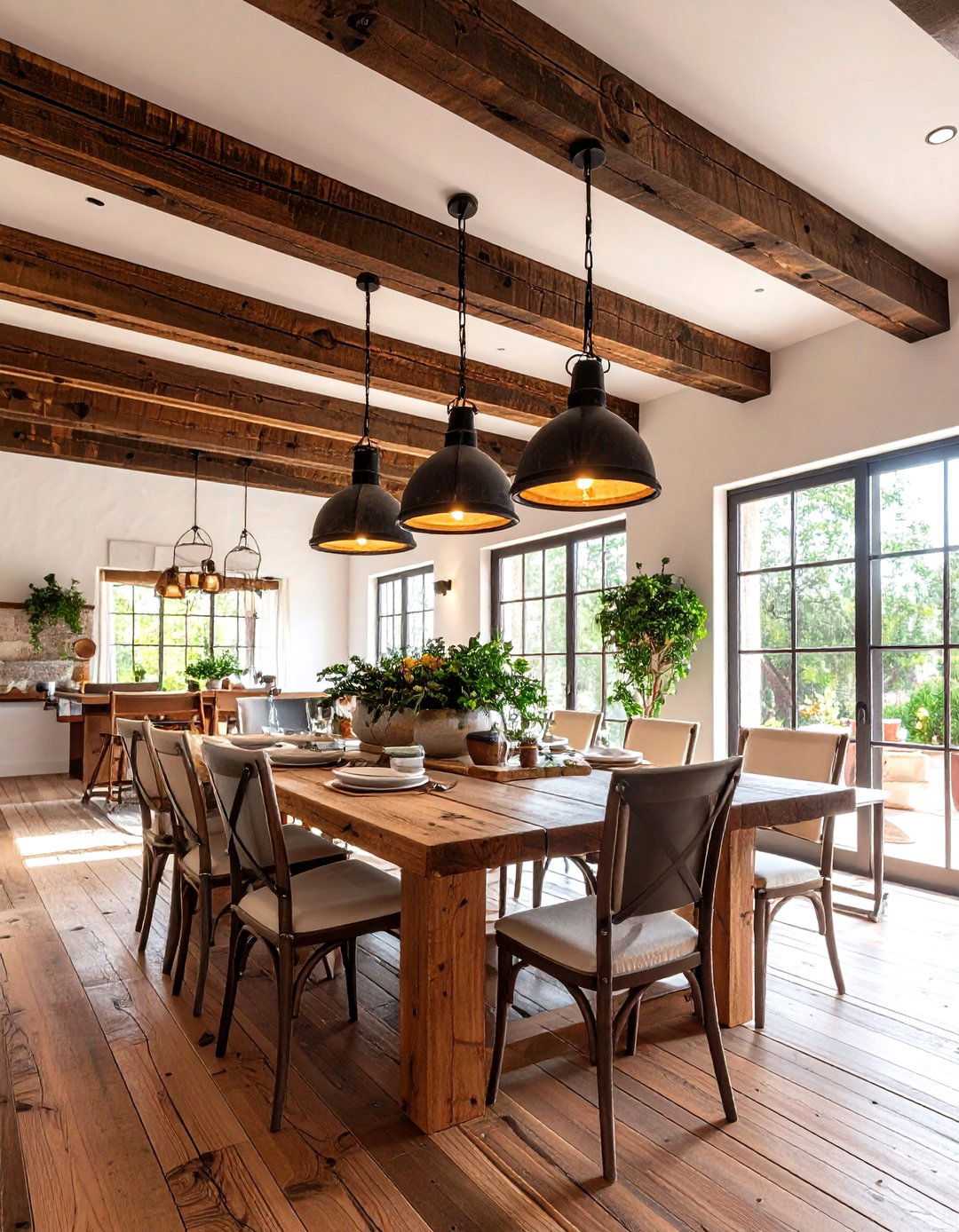
Anchoring a Spanish dining room with chunky, exposed ceiling beams instantly conjures hacienda romance. Hardwood timbers stained a rich espresso accentuate chalky plaster walls and draw the eye upward, making even compact rooms feel loftier. Designers often run the beams parallel to the length of the table so the architecture guides conversation down the centerline while visually elongating the space. Add subtle iron strapping at the beam joints to echo historic mission craftsmanship, and pick pendant lighting that hangs just below the beam line for balanced proportion. This centuries-old structural detail remains a signature of today’s Spanish revival remodels, prized for its warmth and character.
2. Terracotta-Tiled Spanish Dining Room Floor

Stepping onto a terracotta tiled floor grounds the dining experience in sun-baked authenticity. The reddish clay’s variegated coloring hides scuffs, stays cool in summer, and pairs beautifully with carved dark furniture. Lay the tiles in a staggered brick pattern or classic quatrefoil for extra movement, and finish with a natural beeswax sealer to deepen tone over time. If your subfloor cannot accept heavy clay, consider thinner porcelain look-alikes rated for high traffic but still delivering that earthy hue. Combine the flooring with crisp white walls to keep the palette fresh, allowing vibrant table linens or artwork to sing without visual overload.
3. Wrought-Iron Spanish Dining Room Chandelier
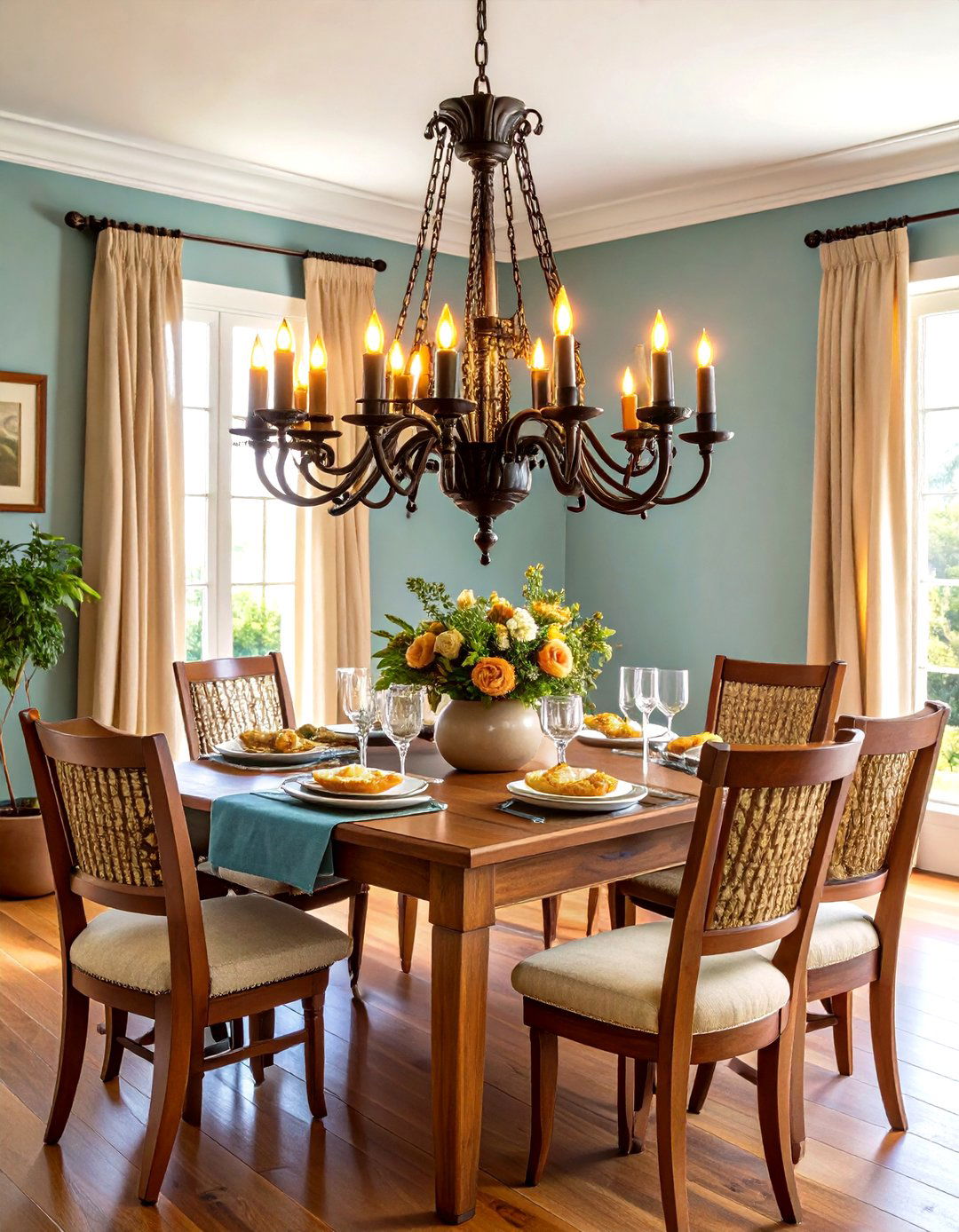
Suspending an oversized wrought-iron chandelier instantly sets a Spanish dining room aglow with Old-World drama. Choose a fixture with scrolling arms, hammered texture, and candle-style bulbs to mimic the hand-forged lights found in Andalusian haciendas. To prevent the piece from feeling heavy, hang it so the bottom sits about 30 inches above the tabletop and pair it with light linen shades or glass hurricanes that diffuse glare. Repeat the iron finish on curtain rods or a fireplace screen for cohesion. This forged lighting not only supplies warm, flattering illumination but also echoes the artisanal metalwork prized in contemporary Spanish revival interiors.
4. Spanish Talavera Tile Accent Wall Dining Room
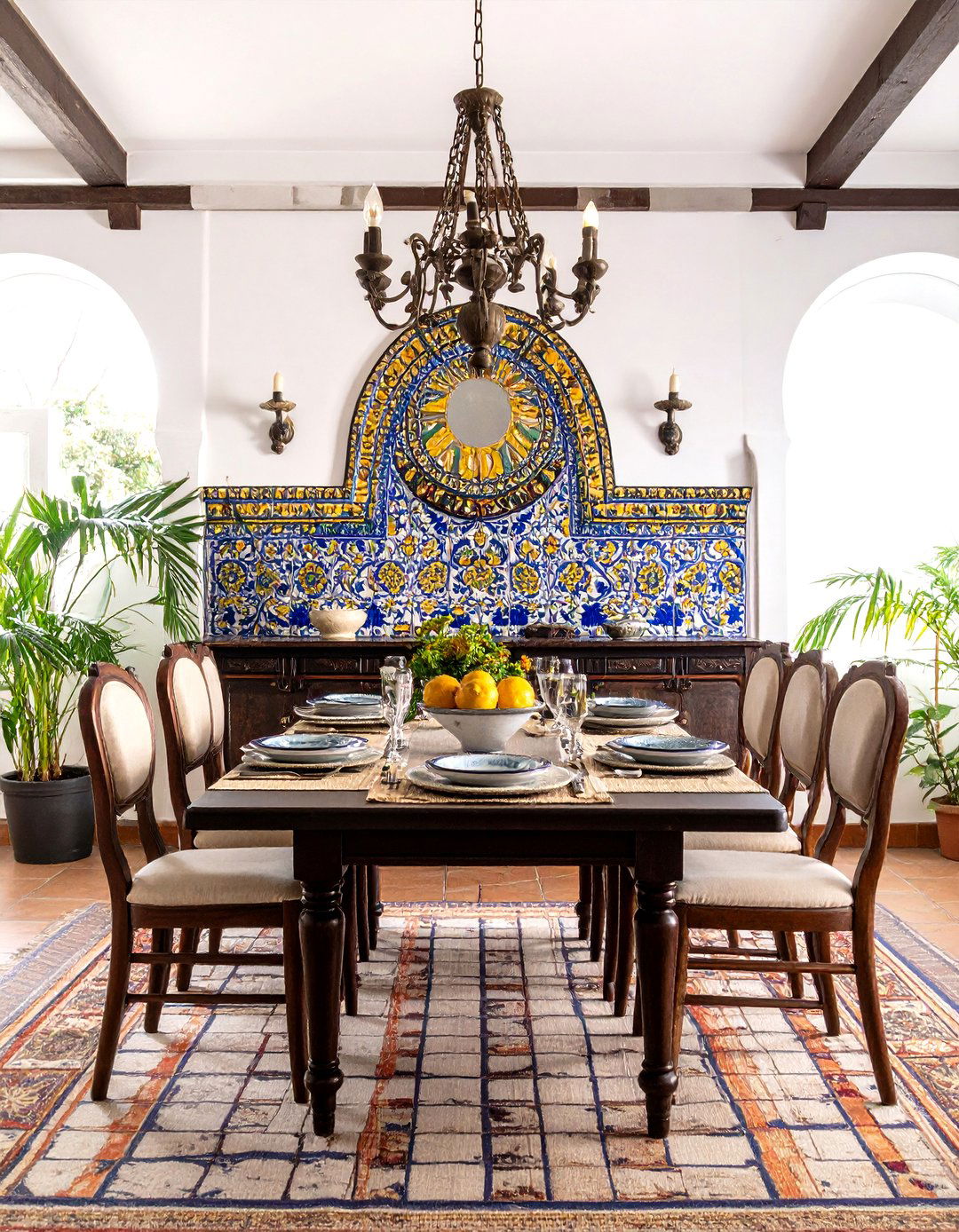
Introducing a splash of hand-painted Talavera tile behind the buffet transforms a plain expanse into a fiesta of color. Opt for traditional cobalt, mustard, and emerald motifs arranged in a repeating grid or create a framed mosaic panel bordered by saltillo trim. Because authentic Talavera is kiln-fired at high temperatures, it stands up to the occasional chair bump or wine splash, making it both decorative and durable. Keep furniture shapes simple so the pattern can shine, and pull one tile hue into your napkins or glassware for effortless harmony. Even a single tiled niche evokes the artisanal heritage of Puebla’s historic workshops.
5. Rustic Reclaimed Wood Spanish Dining Table
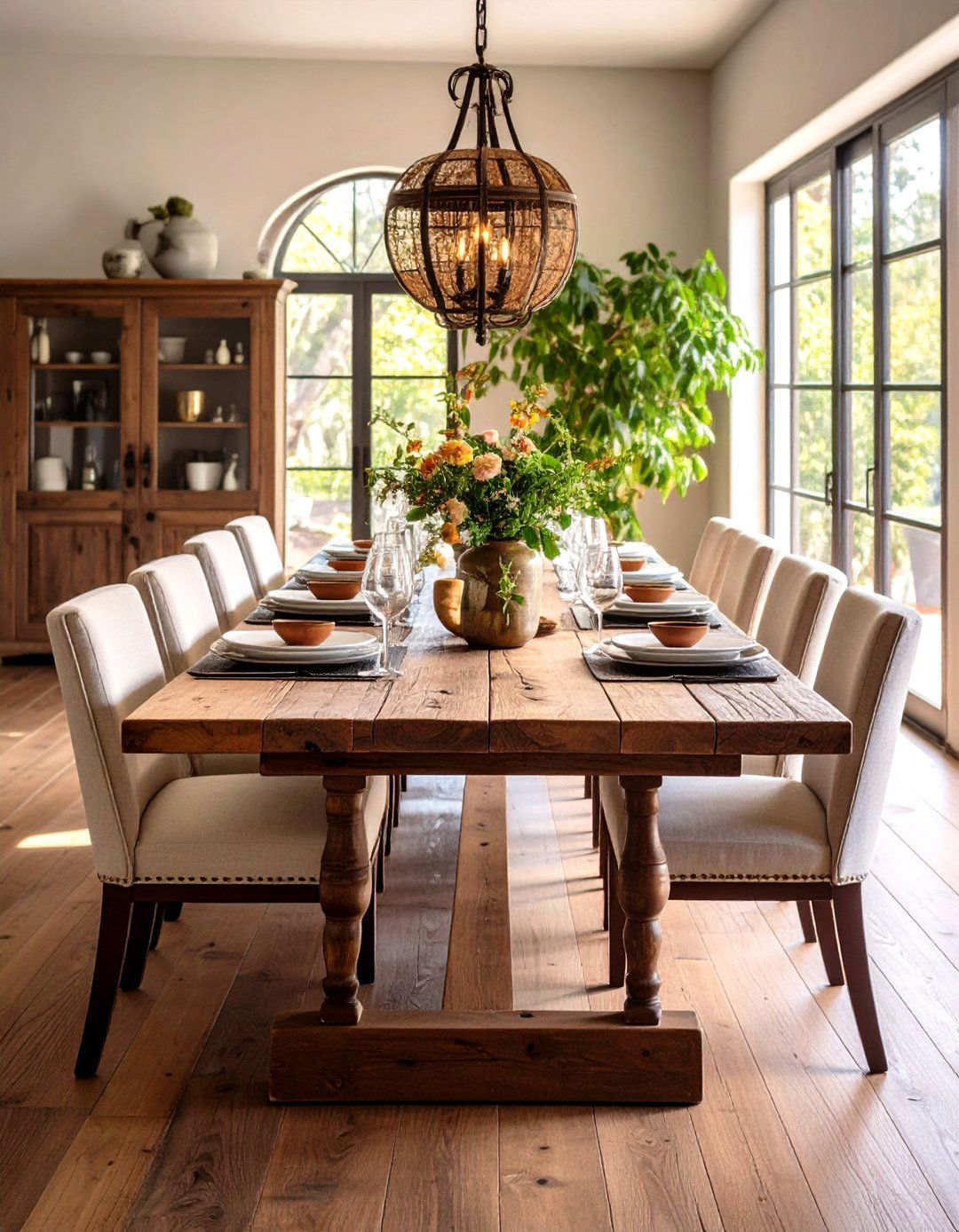
Planting a massive reclaimed-wood table at the room’s heart evokes the rustic hospitality of historic Spanish estates. Boards salvaged from farm gates or wine presses bear saw marks and wormholes that tell a story while resisting everyday dents. Designers recommend a plank top at least 40 inches wide so shared tapas plates fit comfortably down the center, with sturdy trestle legs allowing flexible chair placement. Wax rather than polyurethane protects the patina yet keeps maintenance low. Pair the table with contemporary linen slipcovered chairs for a layered, collected feel—mixing old timber and new textiles, just as many modern Spanish revival designers do.
6. Spanish Leather Equipale Chair Seating

Swapping standard dining seats for hand-stitched leather equipale chairs brings instant Mexican-Spanish flavor and unbelievable comfort. Crafted from pigskin stretched over woven cedar frames, the barrel-shaped forms flex slightly as guests lean back, encouraging long sobremesa conversations. A honey or saddle finish marries well with terracotta tile, while whitewashed versions feel lighter against dark beams. Because the hides are naturally breathable, equipales remain cool in warm climates yet feel cozy during cooler months. Layer a patterned Otomí cushion if extra height is needed, and protect floors with felt pads under the raw cedar feet. Their artisanal irregularities celebrate the hand of the maker, not factory perfection.
7. Spanish Baroque Carved Sideboard Statement
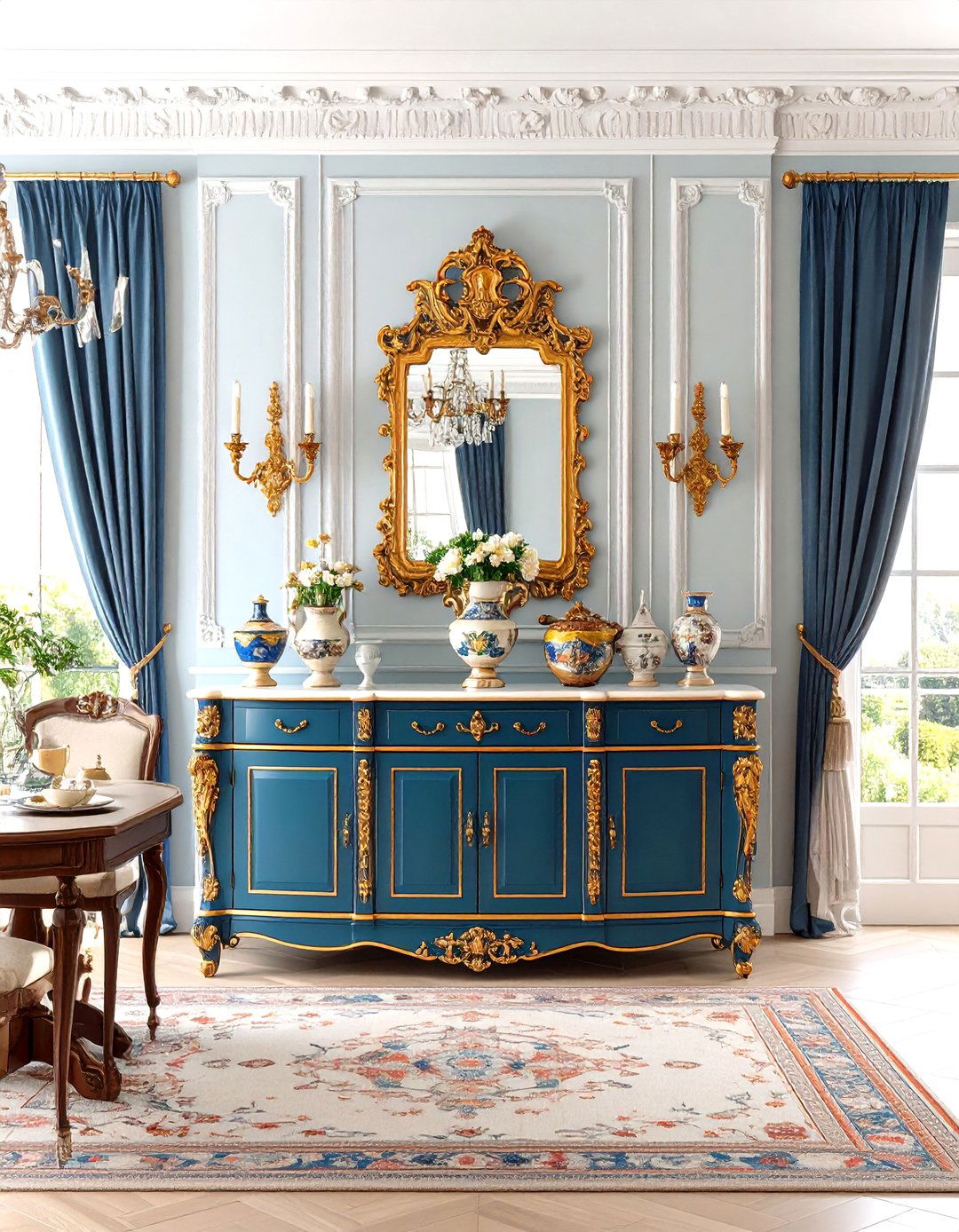
Installing an ornately carved Spanish Baroque sideboard along one wall adds sculptural presence and invaluable storage. Ornamental reliefs, iron clavos, and leather-clad panels echo cathedral craftsmanship while the generous drawers hide extra flatware, linens, and candles. Choose a model no deeper than 20 inches to maintain walkway clearance, and anchor it with a large gilded mirror to bounce light around the room. For a collected look, style the top with a mix of antique pitchers and modern pottery in earthy glazes. Investment pieces like these hold their value and can be passed down as family heirlooms—exactly why dealers see steady demand for authentic Spanish cabinets.
8. Moorish Archways Framing Spanish Dining Room
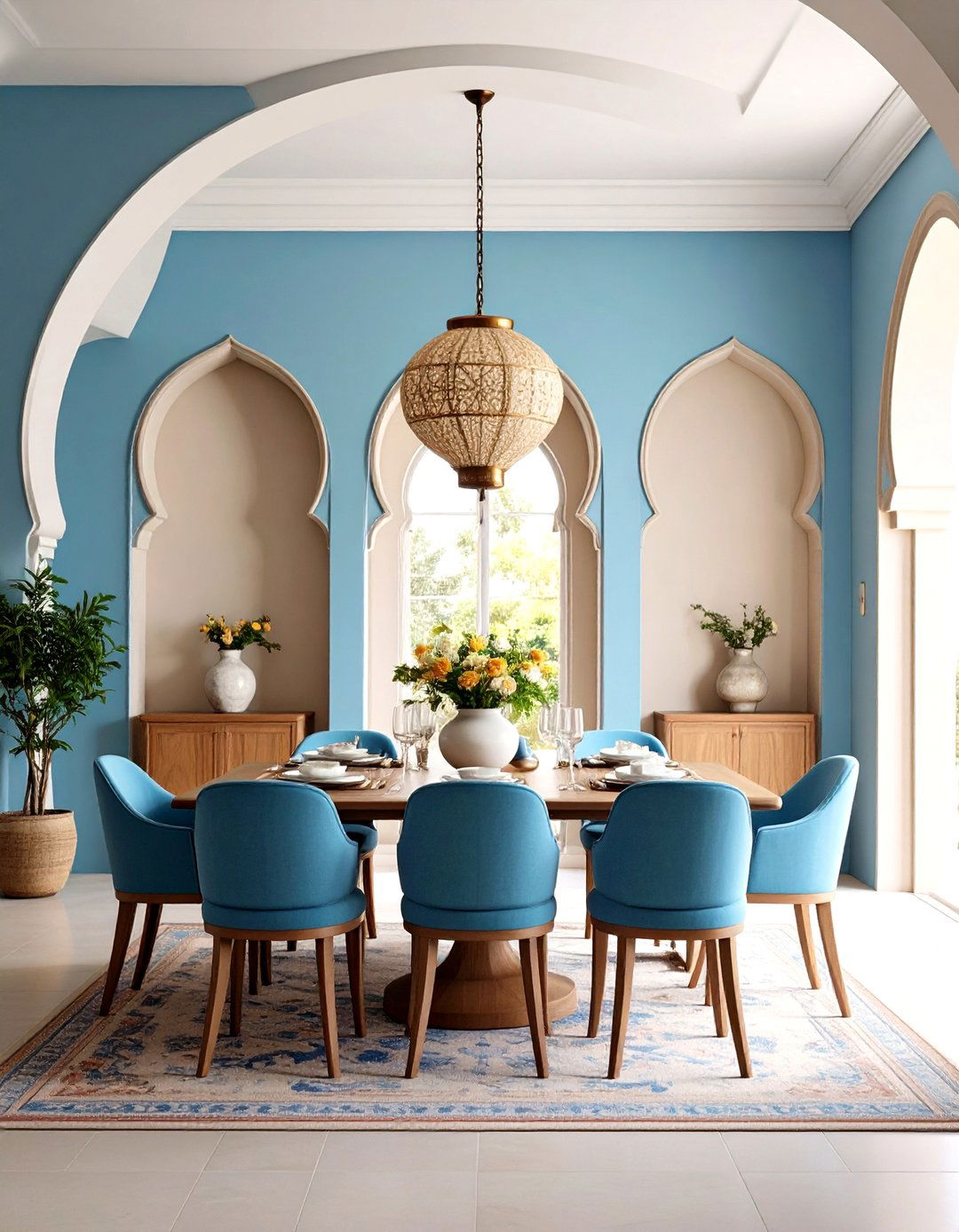
Framing the dining zone with keyhole or horseshoe archways weaves a subtle Moorish thread through Spanish design history. Construct arches in lightweight drywall if masonry isn’t feasible, and finish them with hand-troweled plaster for soft edges that catch evening light. Painting the inside curve a slightly deeper neutral than adjacent walls emphasizes depth without feeling busy. When ceiling height allows, echo the shape in a recessed niche or arched window to reinforce the motif. This architectural gesture not only defines the room but also provides a graceful transition between kitchen, patio, and living areas—mirroring the indoor-outdoor flow found in classic Andalusian homes.
9. Whitewashed Plaster & Dark Wood Spanish Contrast
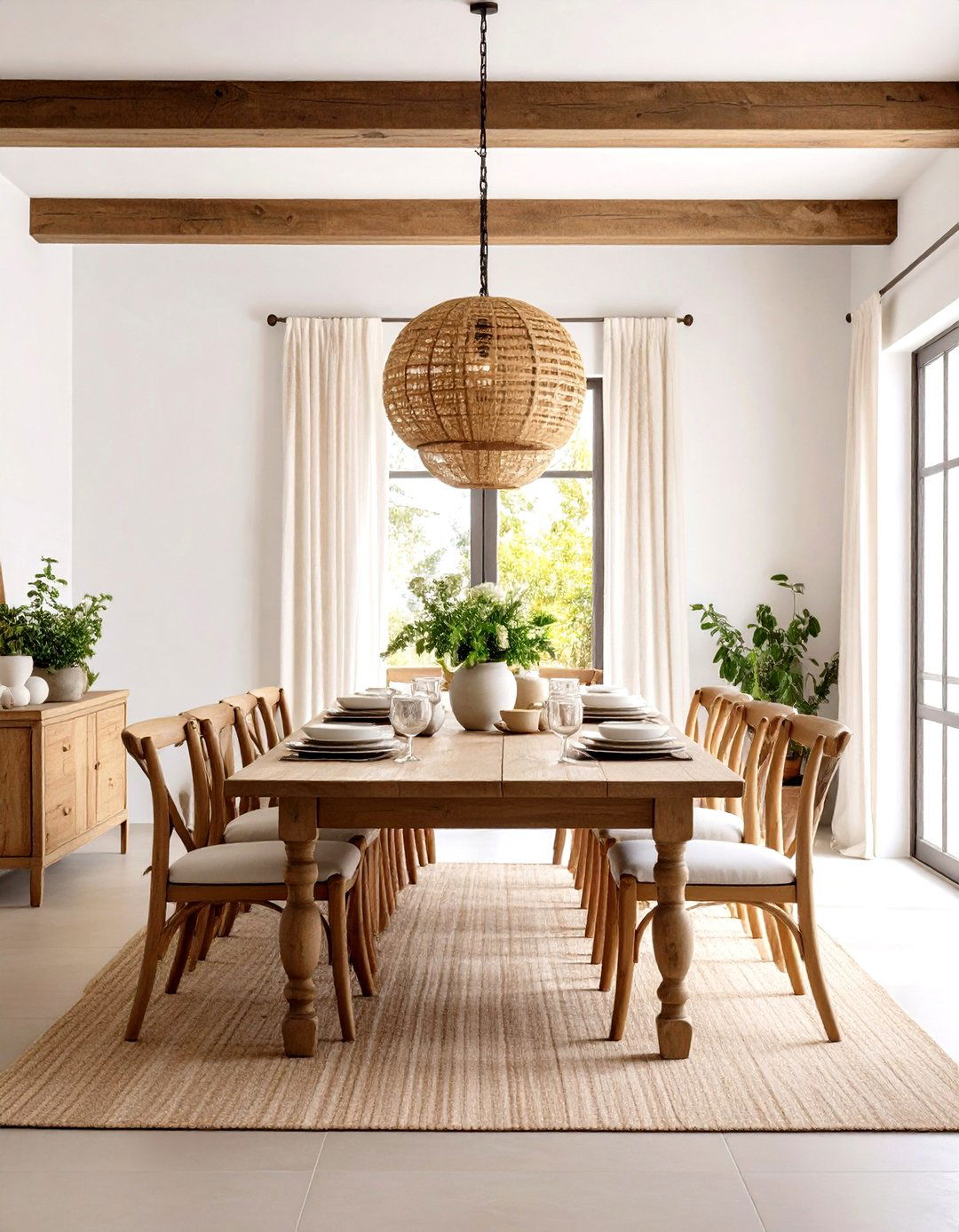
Setting chalky white plaster walls against espresso-stained wood creates the high-contrast palette beloved in Spanish revival dining rooms. The bright surfaces amplify natural light, while the dark tones in ceiling beams, shutters, or furniture ground the scheme. To keep the look current, choose a limewash finish that shows delicate brush strokes rather than a perfect paint job; the subtle variation adds depth and nods to centuries-old building techniques. Furnish with simple silhouettes so the interplay of texture and tone remains the star. If you crave softness underfoot, layer a muted jute rug that fades quietly into the background instead of competing colors.
10. Indoor–Outdoor Courtyard Spanish Dining Room
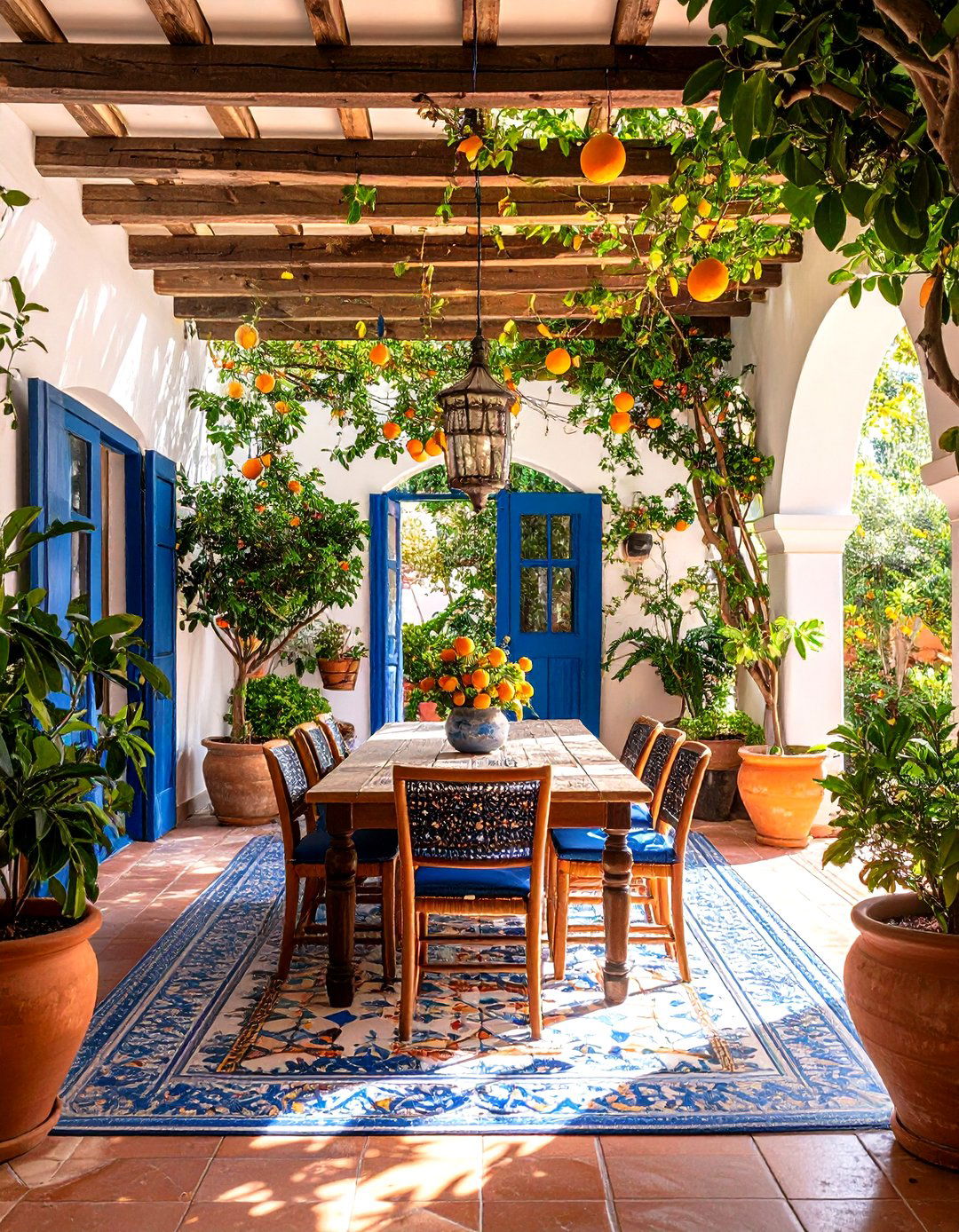
Opening French or steel-framed doors to a sunny courtyard lets a Spanish dining room breathe, blurring the line between interior and garden. Potted citrus trees, terra-cotta planters, and string lights extend the décor palette outside so guests feel enveloped by the same warm materials. When square footage is tight, even a Juliet balcony, herb planter rail, or fold-away window creates a similar al-fresco vibe. Use weather-resistant Sunbrella cushions on dining chairs so seats can shuttle outdoors for extra seating. The seamless flow encourages leisurely weekend lunches that stretch into siesta hour—an everyday pleasure championed by Mediterranean architects for centuries today.
11. Hand-Painted Spanish Ceramic Plate Display
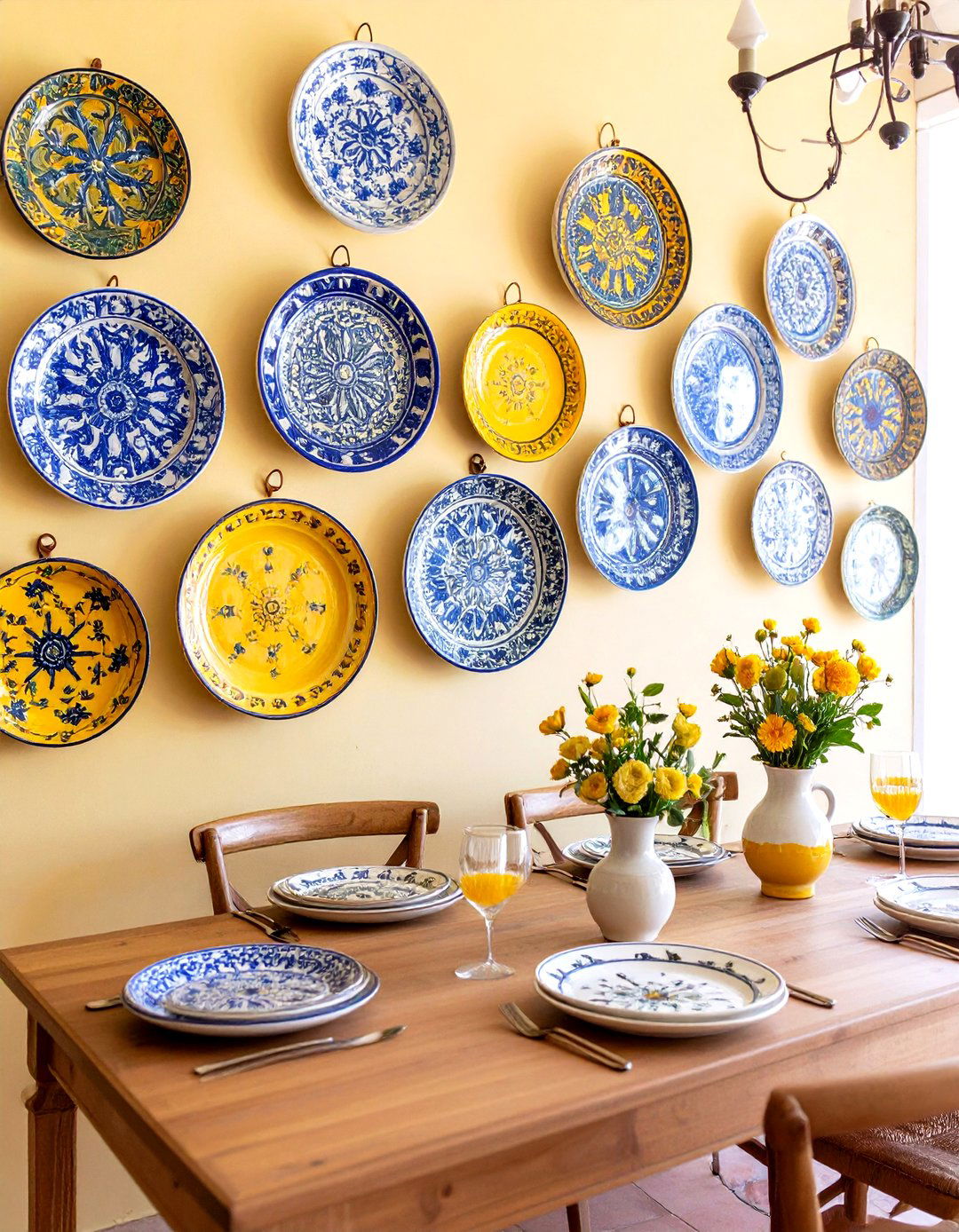
Displaying a collection of hand-painted Spanish ceramic plates on a wall instantly layers color and folk artistry without sacrificing floor space. Arrange the dishes in a loose oval that echoes the curve of the dining table, mixing sizes so the composition feels organic rather than rigid. Use low-profile disc hangers to keep focus on the artwork itself and line the plates with tissue when washing to preserve delicate glazes. Pull accent colors from the pottery—saffron yellow, indigo, sage—to guide napkin or candle choices. The ever-changing arrangement evolves as you find new pieces on travels, creating a living story of shared meals and memories.
12. Spanish Revival Forged Hardware & Doorways
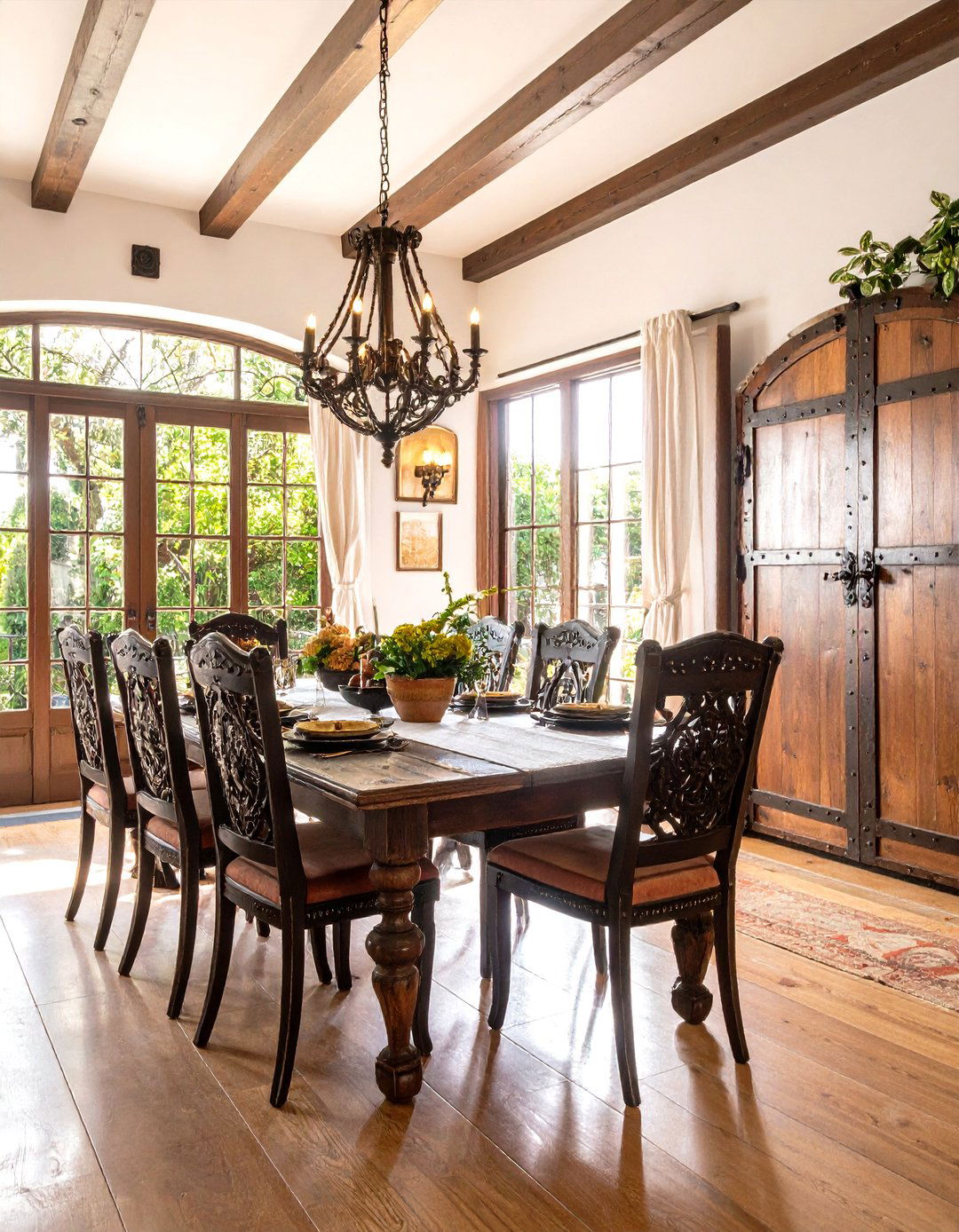
Upgrading door hinges, pulls, and window latches to chunky hand-forged iron provides subtle continuity with other Spanish dining room metals. Opt for rounded strap hinges on cabinet doors and almond-shaped escutcheons on built-in buffet drawers, finishing each piece in a beeswax or oil rub so it ages gracefully. If budgets are tight, start with the room’s main entry door; guests grasping a textured lever immediately sense the craftsmanship inside. Pair metal hardware with wood doors stained just dark enough to highlight grain. These small tactile moments collectively elevate the space, echoing the durable joinery seen throughout traditional Spanish farmhouses everywhere.
13. Spanish Dining Room Plants & Natural Textures
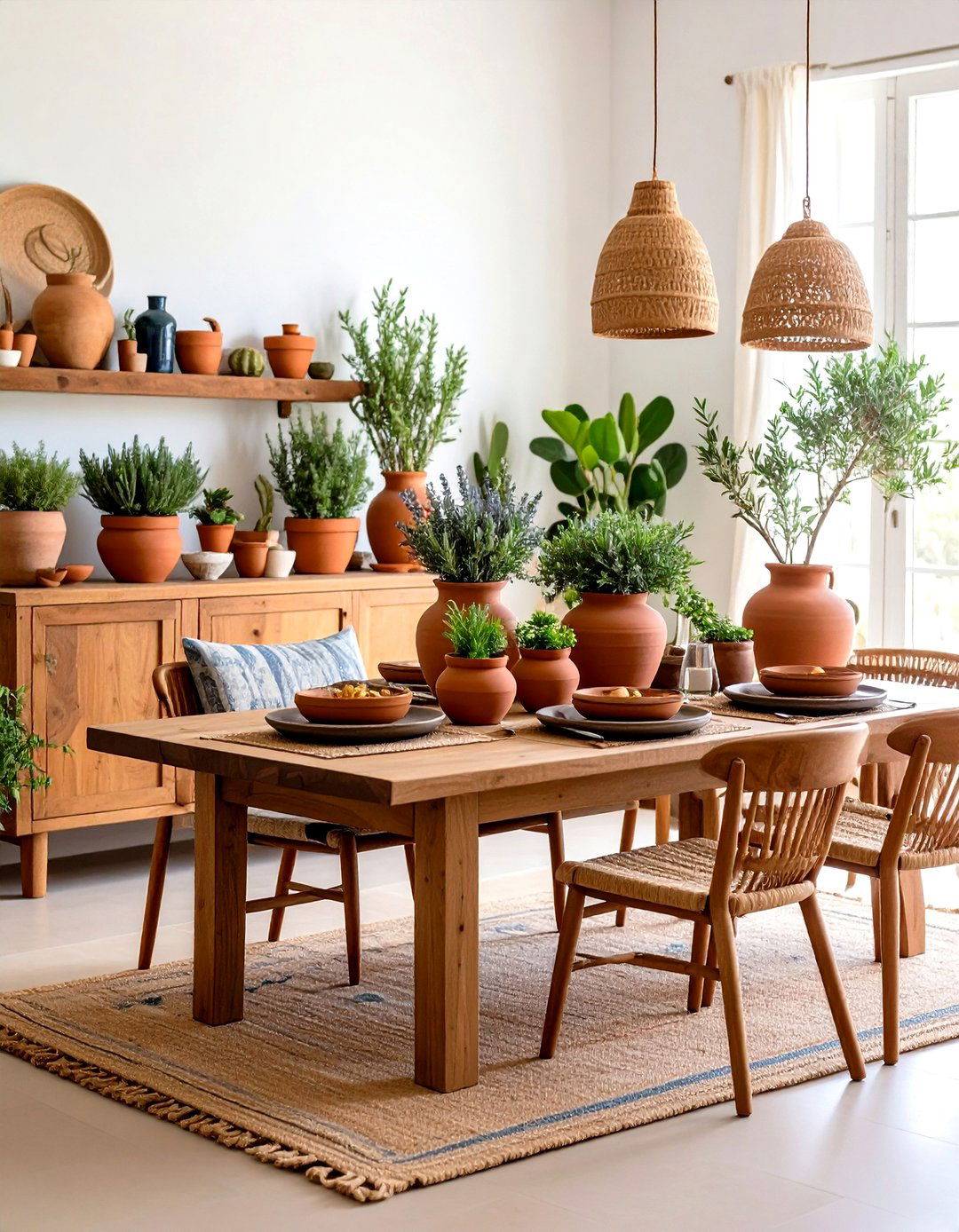
Bringing living greenery to the table is central to the cozy Mediterranean mood trending for 2025 Spanish interiors. Cluster terracotta pots of rosemary, lavender, or olive saplings on a console and weave raffia placemats beneath dishware for tactile depth. Swap polyester runners for undyed linen whose rumpled surface celebrates imperfection. Designers also tuck a single leafy branch in an oversized earthen jug at one corner to create asymmetry without clutter. These organic touches soften hard architectural lines, absorb sound, and release subtle herbal fragrances that heighten appetite—proving that the simplest materials often have the most evocative impact.
14. Spanish Style Tapestry or Textile Wall
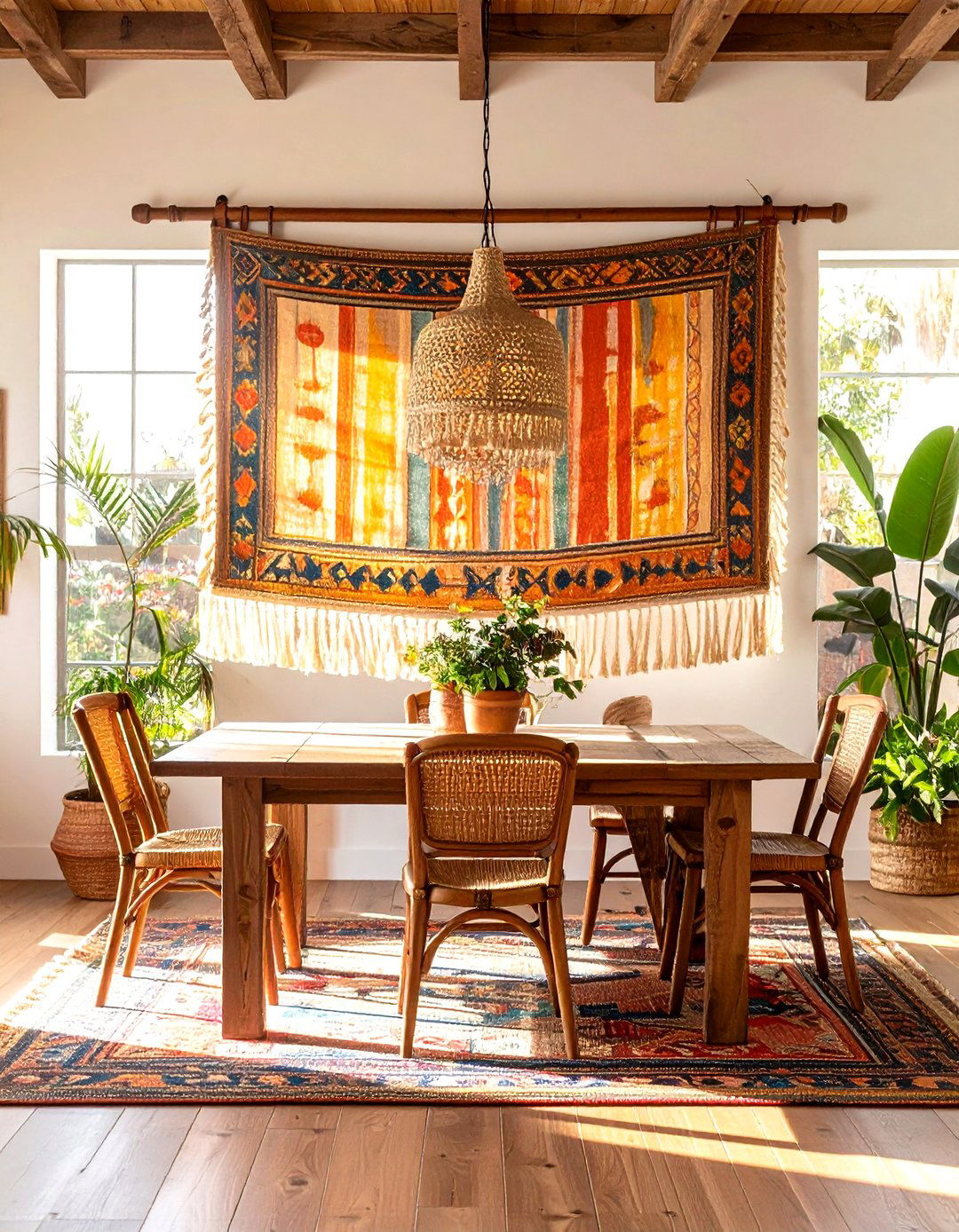
Hanging a woven Spanish or Navajo-woven tapestry behind the head chair bathes the dining room in pattern, sound-softening fiber, and storytelling. Select a textile no wider than two-thirds the table length so it frames rather than overwhelms the setting; an antique Zarape or contemporary kilim both work. Mount on a discreet wooden rod suspended with leather straps that echo chair material. Lighting matters—aim a low-glare picture light at the weave to accentuate color without fading dyes. Beyond aesthetics, the fabric dampens echo in tile-floored rooms, letting guests converse comfortably even during lively family fiestas. Rotate pieces seasonally to refresh the scene.
15. Modern Spanish Minimalist Dining Space
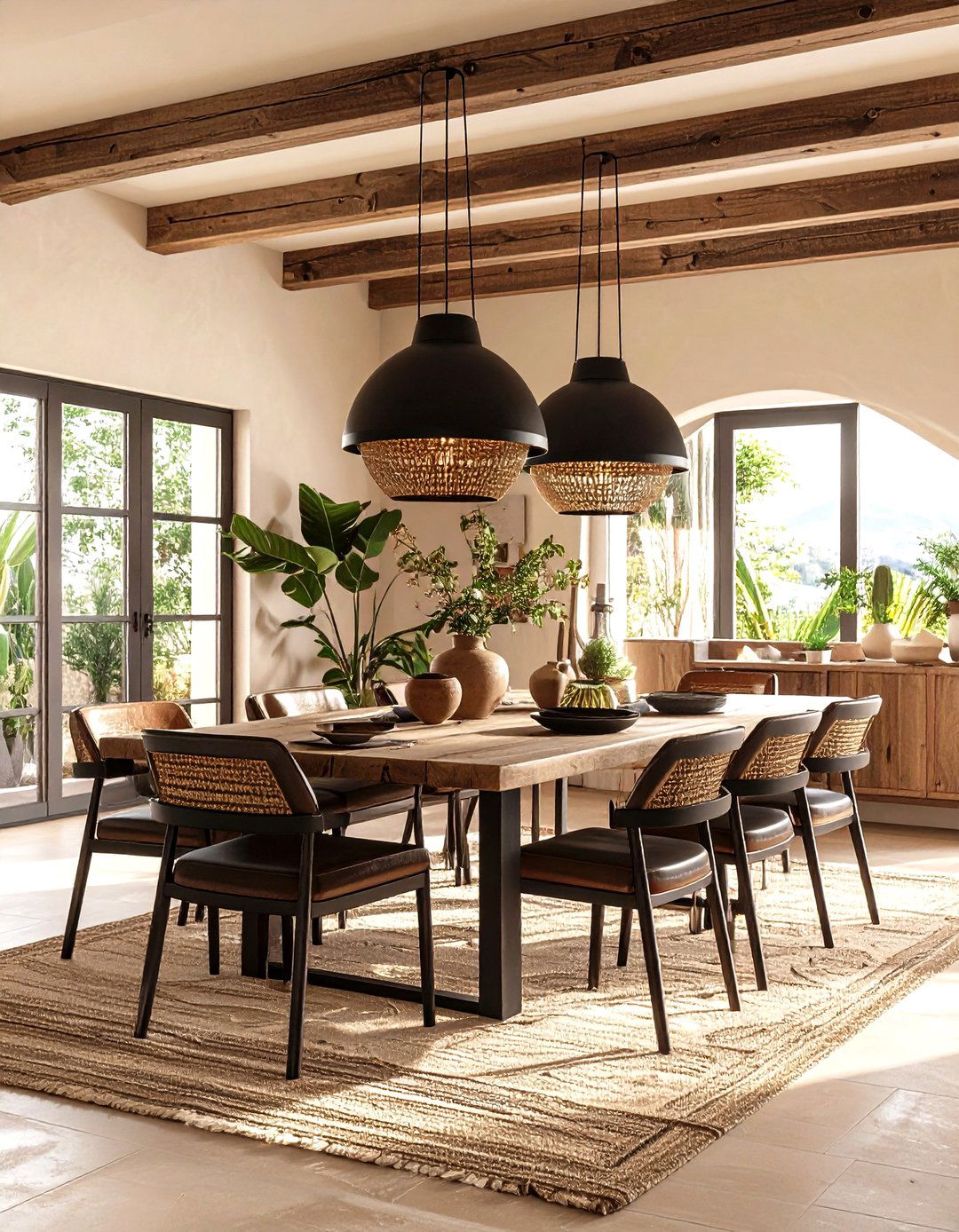
Embracing a pared-back palette proves that Spanish dining rooms needn’t be maximalist. Paint walls warm bone, strip beams to natural oak, and specify matte black lighting with razor-sharp geometry. Furniture can be equally lean: a plank-top table on sculptural steel legs paired with leather sling chairs keeps silhouettes clean while nodding to tradition through material choice. Limit accessories to one oversized ceramic bowl and a rough woven runner; negative space becomes the star. This approach reflects the growing ‘new Spanish minimalism’ movement seen in Los Angeles remodels, where designers enliven historic bones with contemporary simplicity rather than period pastiche.
16. Decorative Spanish Ceiling Tiles & Beams
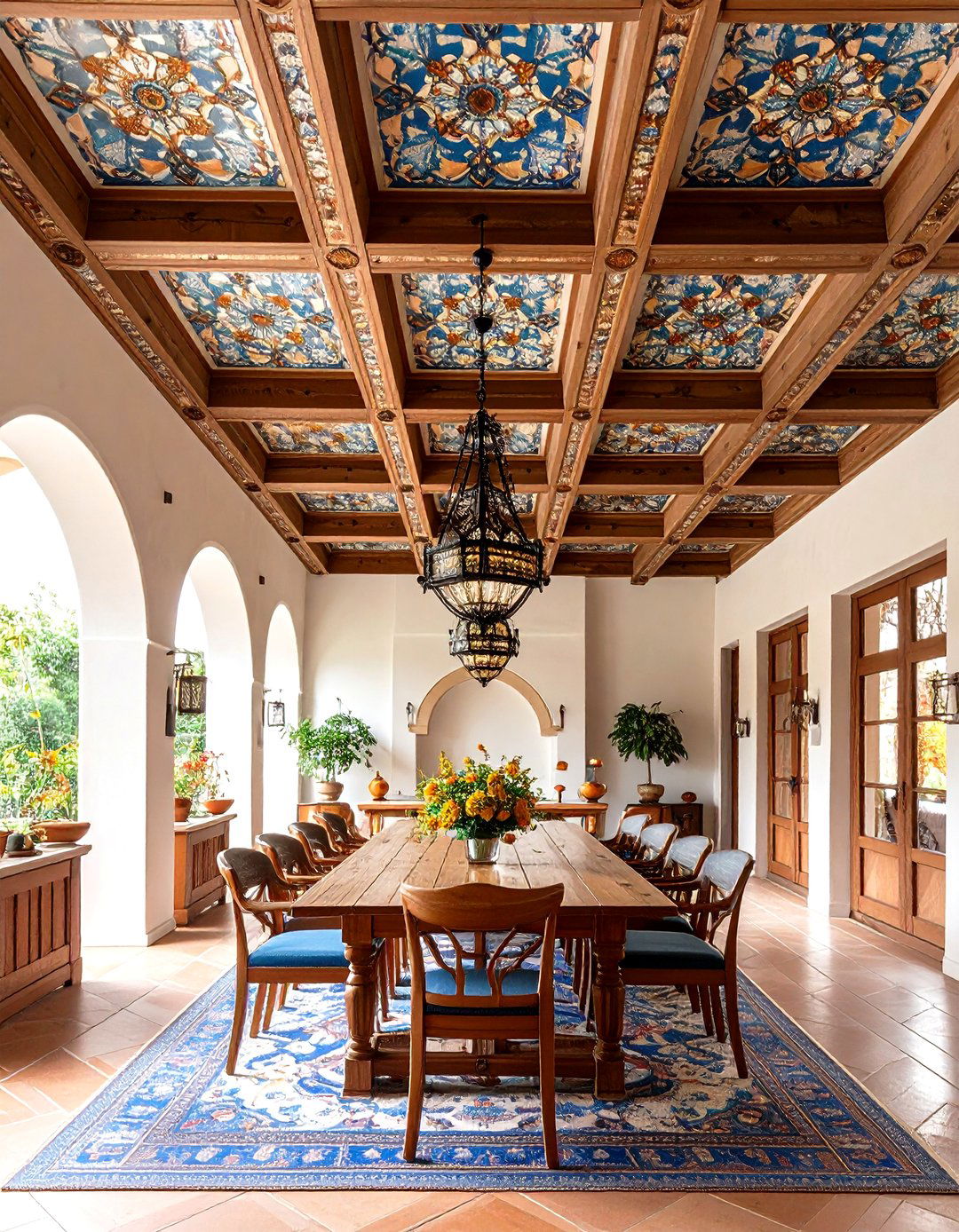
Installing patterned tin or polychrome wood coffers between existing beams instantly elevates a Spanish dining room to hacienda grandeur. Lightweight polyurethane tile panels mimic carved cedar yet attach with standard adhesive, allowing renters to upgrade without structural work. Select motifs inspired by Seville cathedral ceilings—rosettes, starbursts, Moorish knots—and finish in muted ochre or soft verdigris to avoid overpowering. When lighting is dimmed, the recessed geometry casts dramatic shadow play that doubles as ornament. This layered ceiling treatment heightens acoustics and hides modern wiring, making it a favorite tactic in luxury Spanish revival restorations from Beverly Hills to Barcelona today homes.
17. Vintage Wicker & Terracotta Spanish Dining Mix
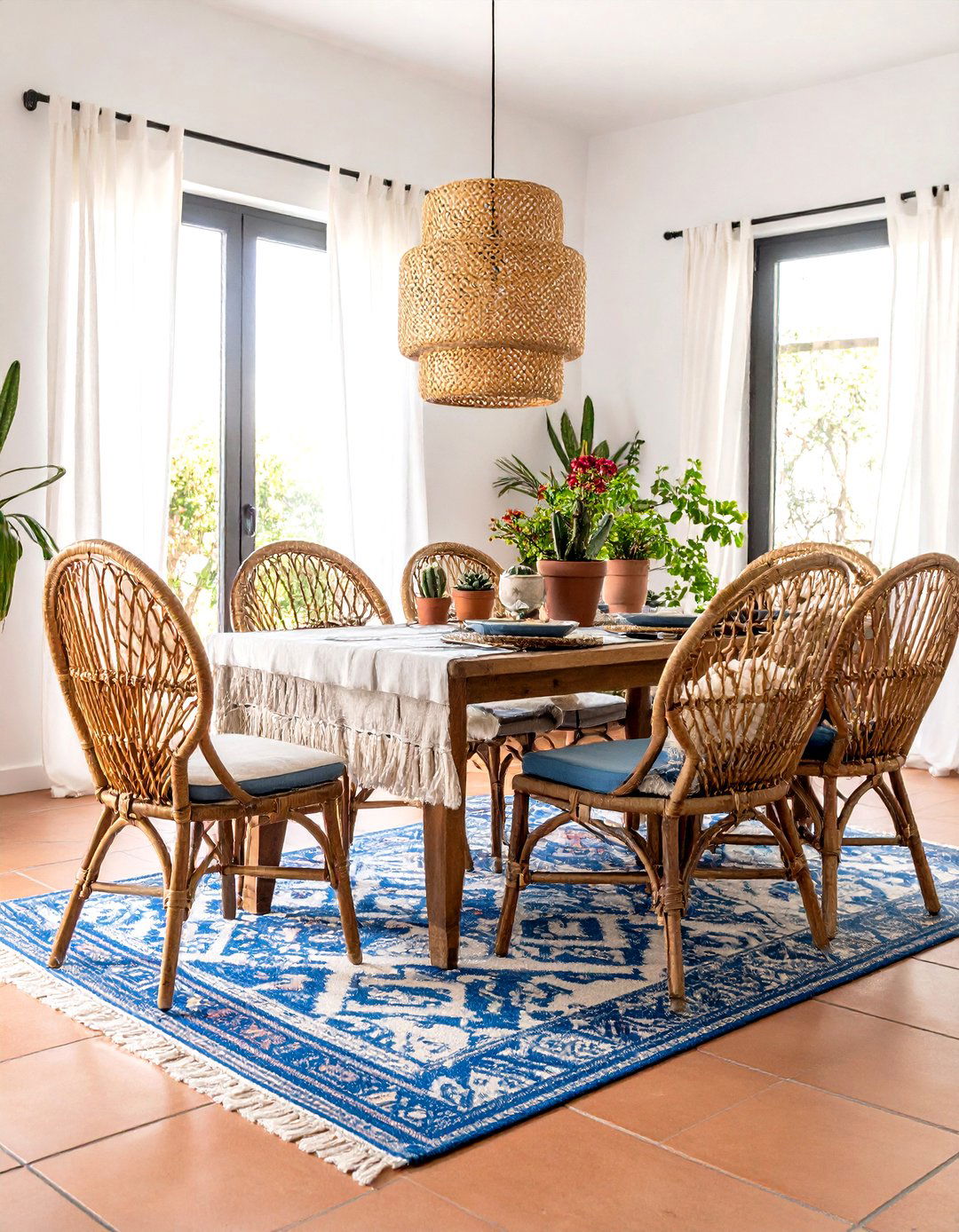
Combining vintage wicker chairs with terracotta floor tiles channels the laid-back 1970s Spanish-Mediterranean aesthetic returning to vogue. Look for high-back peacock or fan shapes to add sculptural height without blocking sightlines, and balance their light texture with a sturdy wood table. Because both materials share warm, earthy undertones, they harmonize instantly; a kilim cushion or sheepskin throw offers extra comfort on cooler evenings. To prevent scratching clay tiles, trim wicker feet with clear vinyl caps. The playful interplay of handmade ceramics, rattan, and potted succulents evokes vacation villas—and proves that relaxed, joyful design never truly goes out of style anywhere.
18. Spanish Dining Room Benches & Built-In Bancos
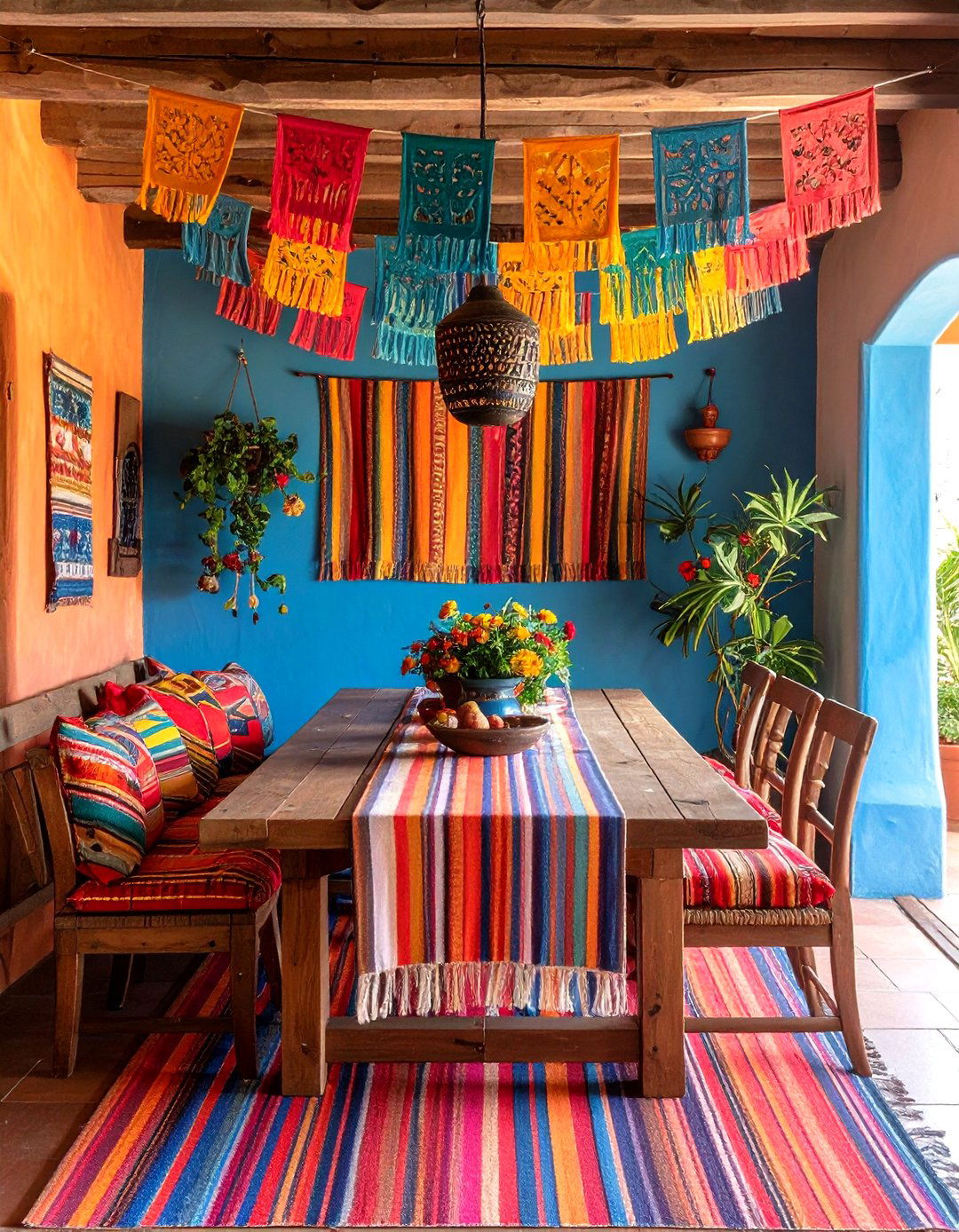
Replacing several chairs with a built-in banco or freestanding wood bench instantly communicates communal Spanish dining culture. Construct the seat from pine or cedar, then top with a long striped serape cushion and scatter bolster pillows so guests of different heights find support. Benches tuck completely under the table, saving floor space in narrow rooms, and they encourage casual seating numbers to expand for fiestas. If building into a stucco wall, include a shallow niche above for candles or pottery. The result echoes centuries-old mission refectories where families gathered for hearty meals after long days in the fields each night.
19. Dramatic Spanish Candlelit Dining Atmosphere
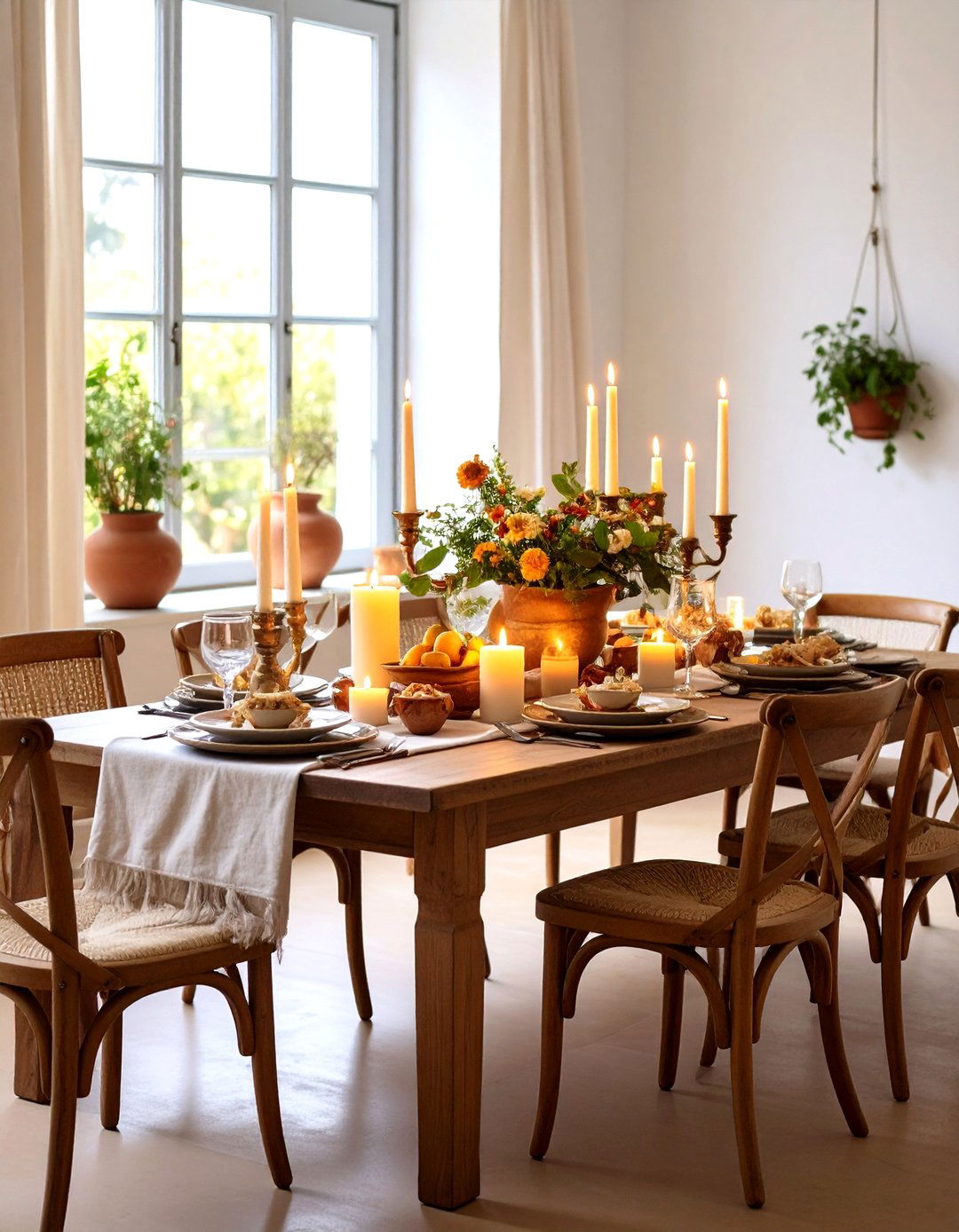
Layering candlelight at multiple heights imbues a Spanish dining room with romantic intimacy reminiscent of historic tapas bars. Anchor the table with a row of wrought-iron candelabras, flank the sideboard with tall hurricane lanterns, and scatter petite clay votives along the windowsill. Unscented beeswax pillars lend a subtle honey aroma without competing with food. To avoid soot on white walls, trim wicks to a quarter inch and choose dripless varieties. This soft, flickering glow flatters complexions and bounced off terracotta floors multiplies warmth—proof that electricity isn’t always necessary for ambiance. End the evening by dimming overhead lights so candles become the primary source, just like in old haciendas.
20. Spanish Dining Room Patterned Tile Rug Alternative
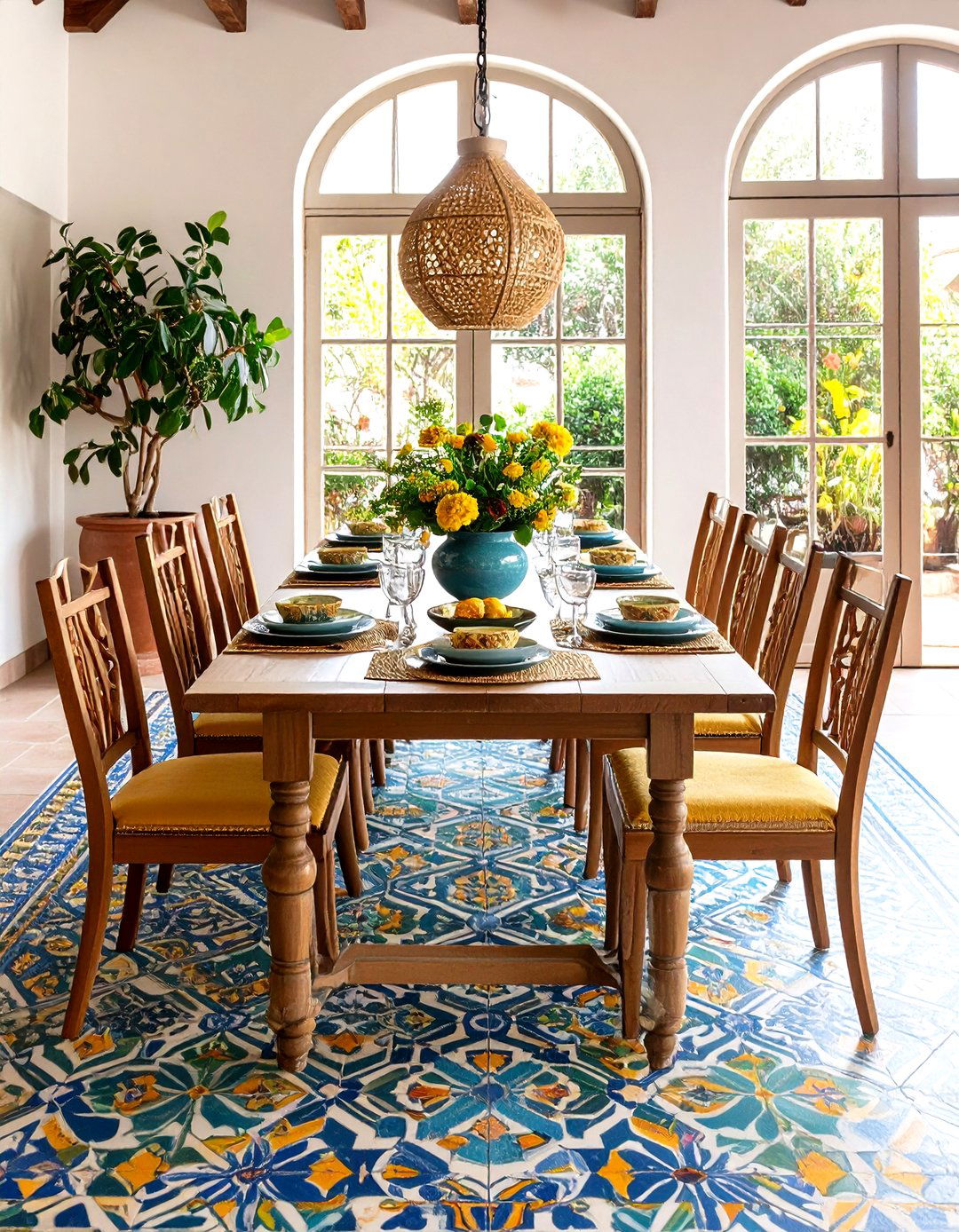
Swapping a traditional fabric rug for a patterned encaustic cement tile ‘carpet’ offers Spanish style, durability, and easy cleanup. Lay the geometric field directly under the dining table, framing it with a narrow border tile in a solid hue so the pattern reads as a defined island. Because the surface is level with the surrounding floor, chairs slide smoothly and crumbs sweep away with a quick sweep. Select colors echoed elsewhere—perhaps the sage of a plate or the saffron of a tapestry—to pull the scheme together. Radiant heating below the tiles keeps toes warm in cooler months, marrying beauty with modern comfort.
Conclusion:
From timber beams overhead to colorful tiles underfoot, Spanish style thrives on craftsmanship, natural materials, and a sense of convivial ease. Mix and match the twenty ideas above—or adopt just one thoughtfully executed feature—and your dining room will radiate warmth year-round. Remember to balance texture with light, old pieces with new, and function with flair; Spanish design is less about strict rules than about inviting people to linger at the table. ¡Buen provecho!



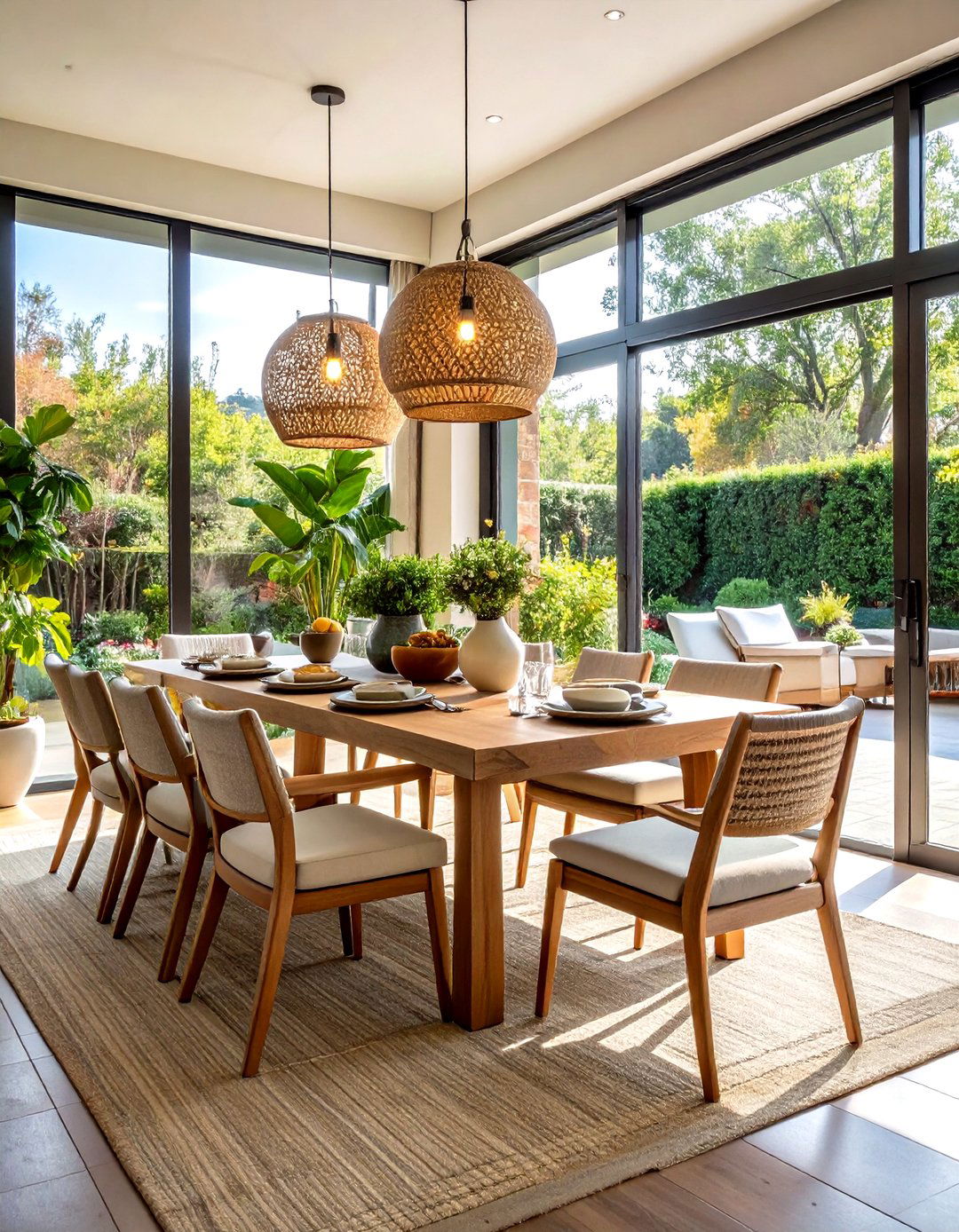
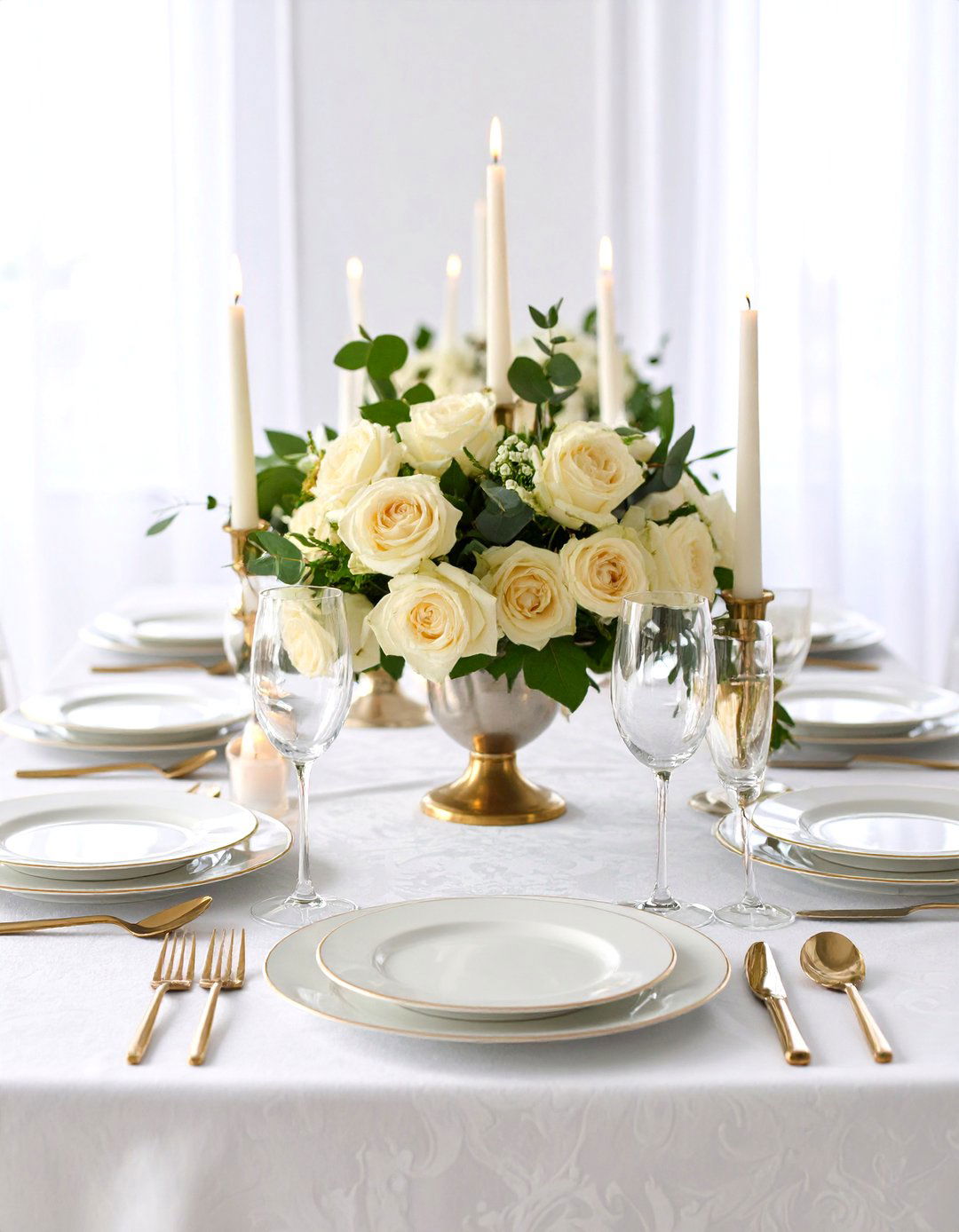
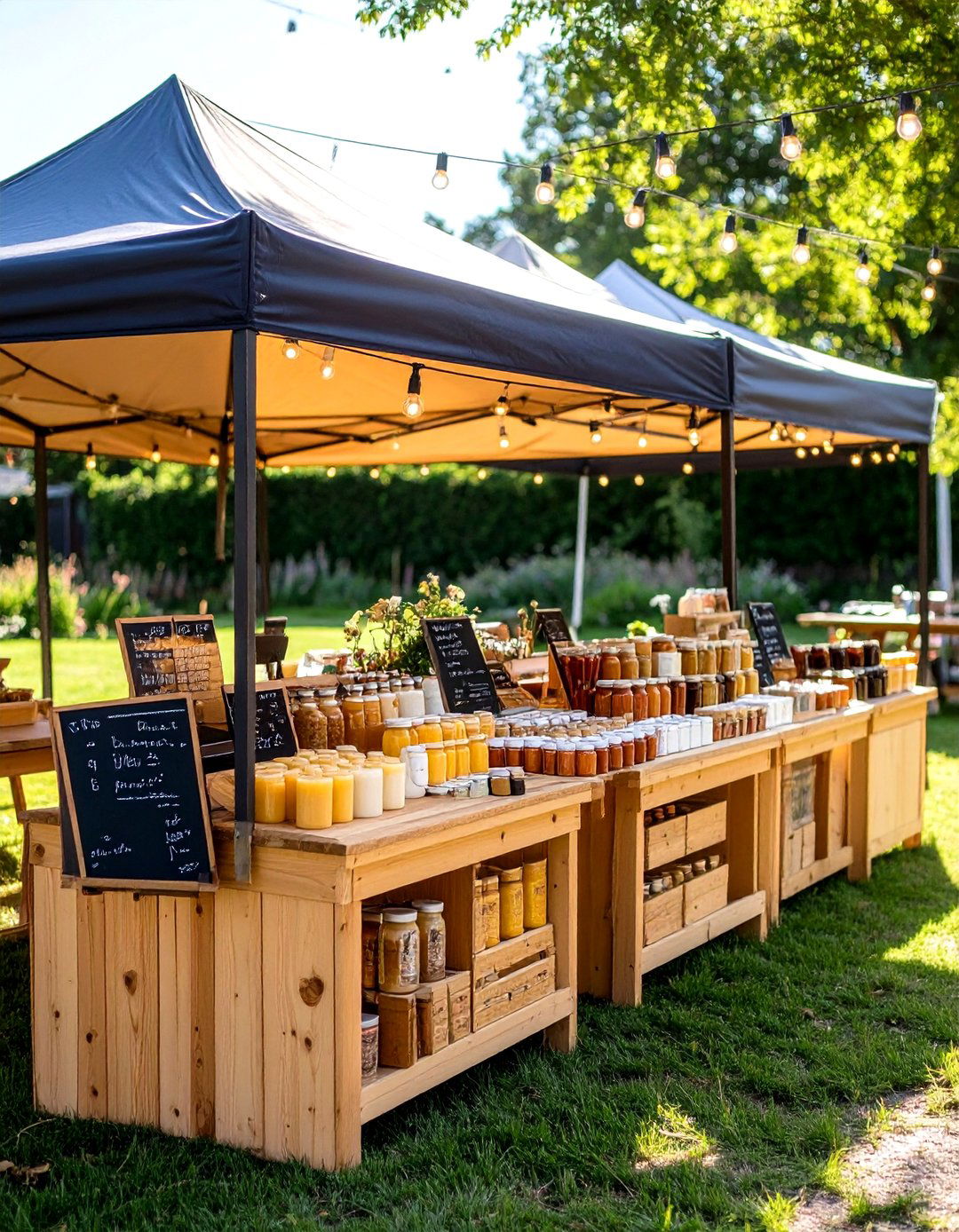
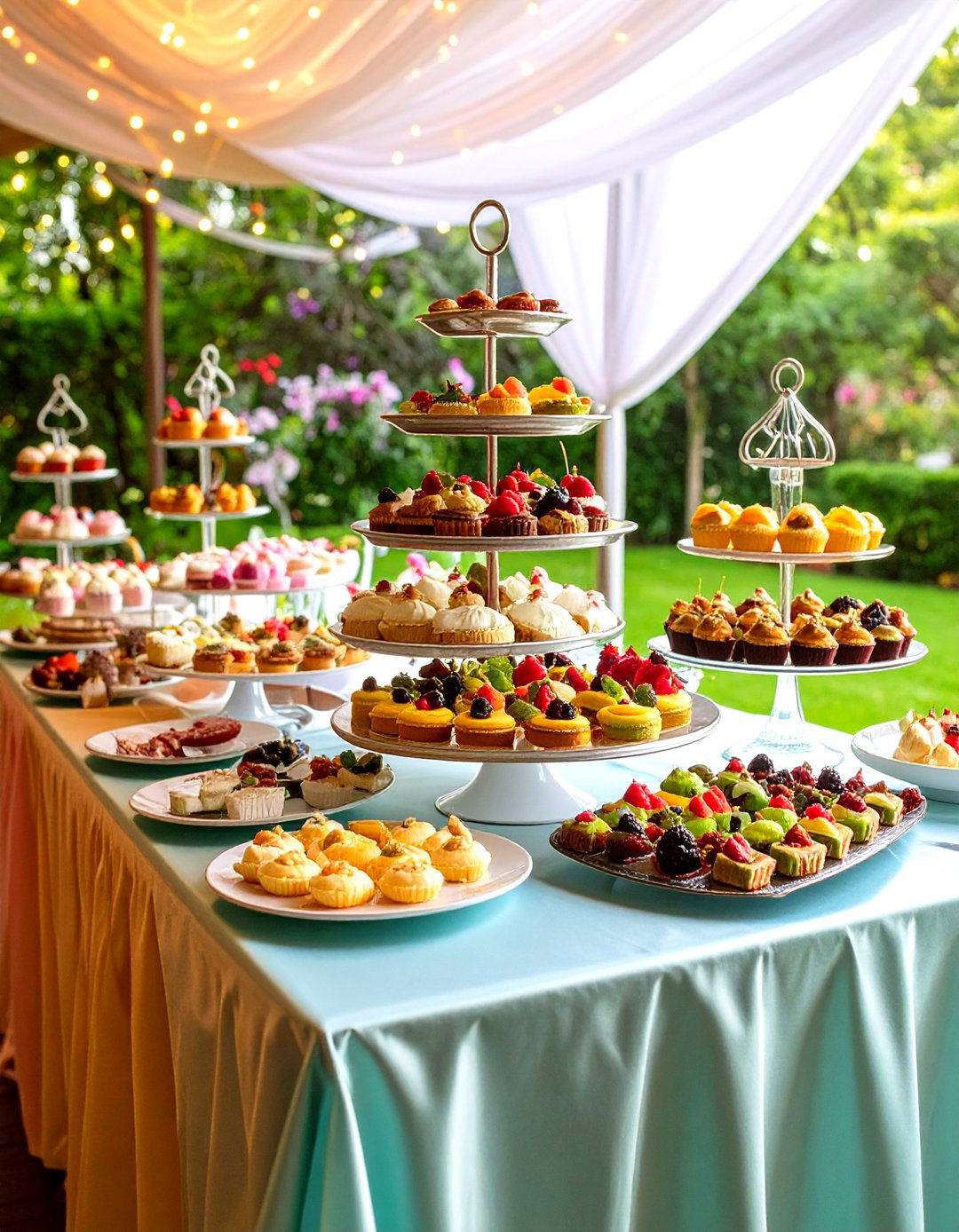
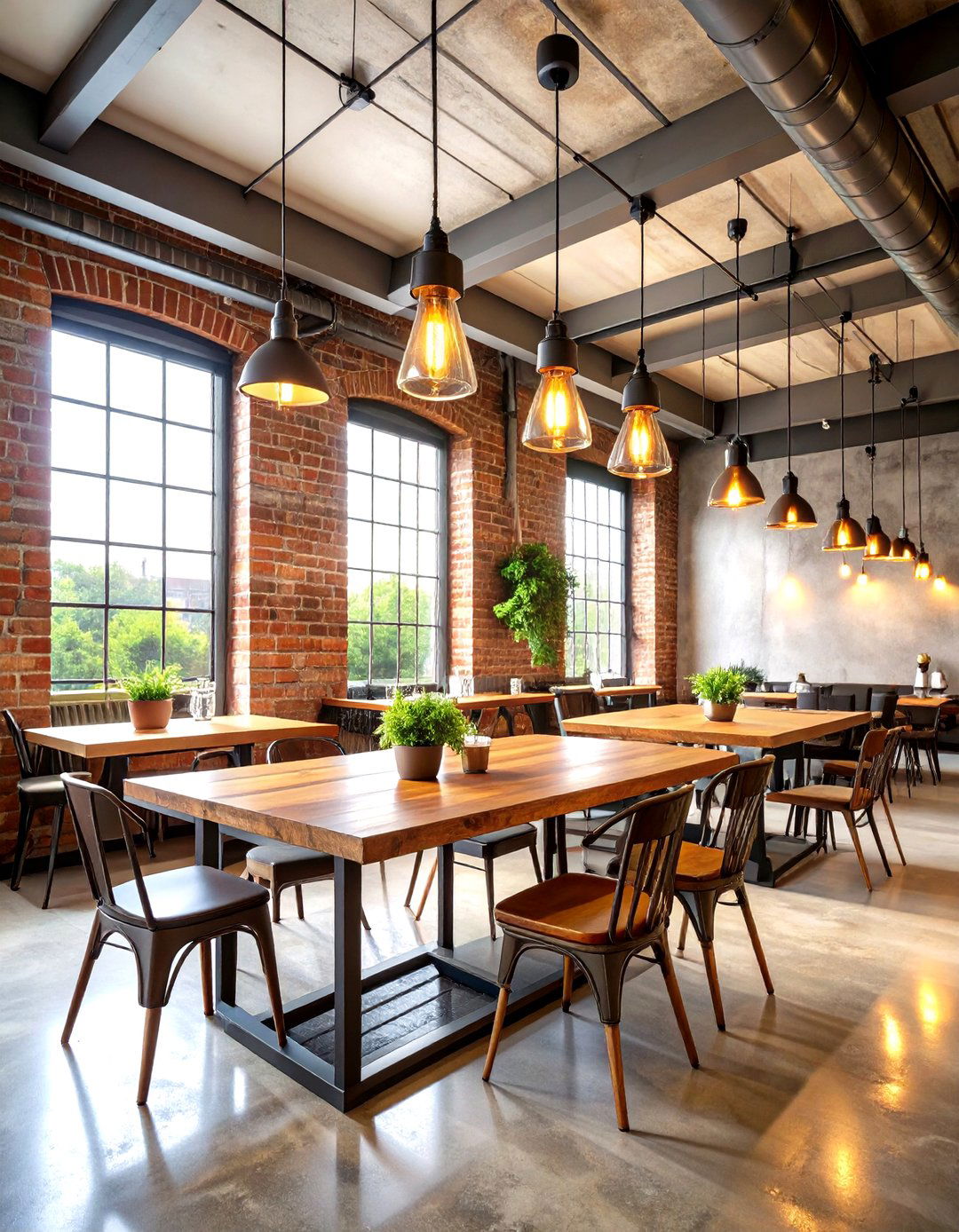
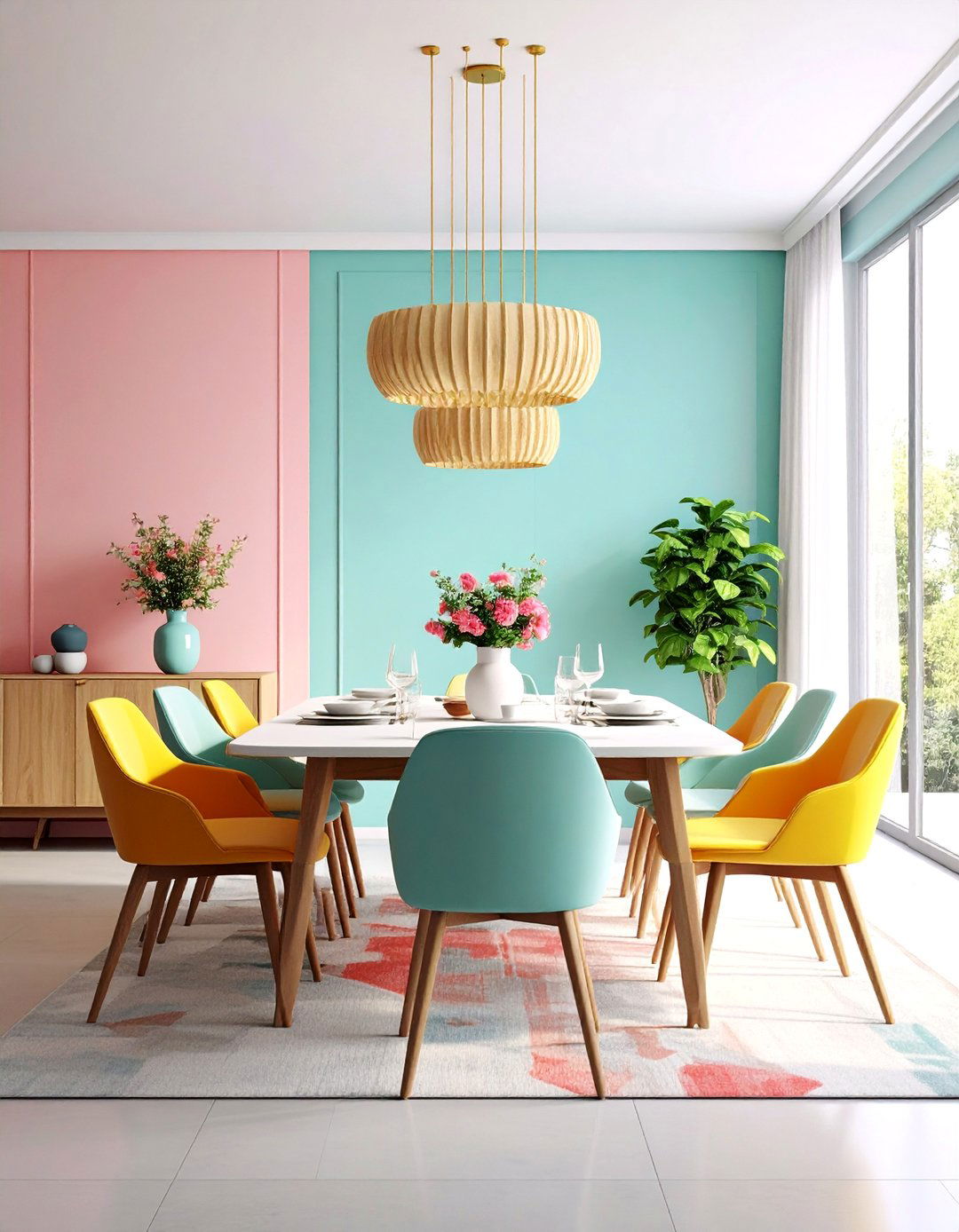
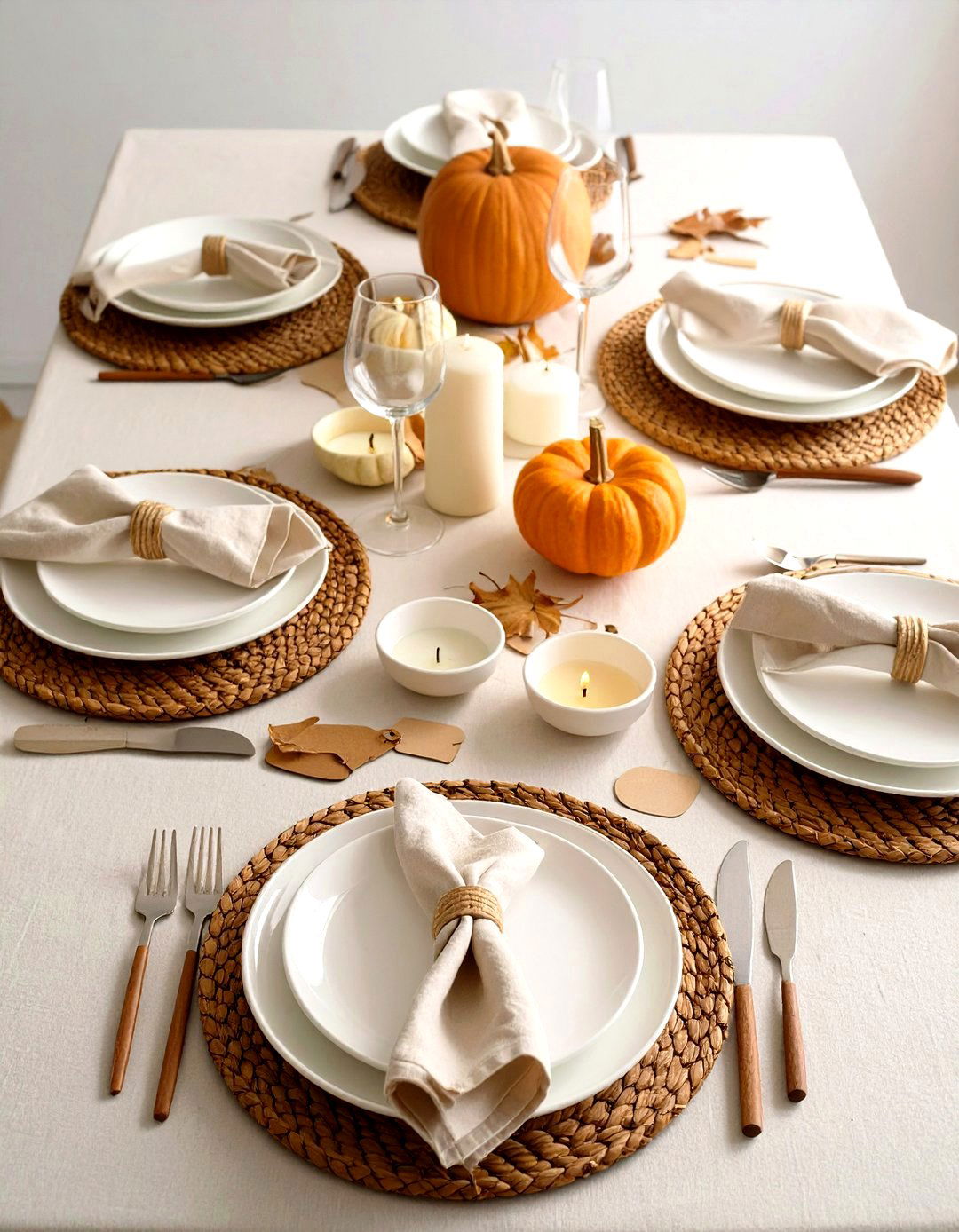
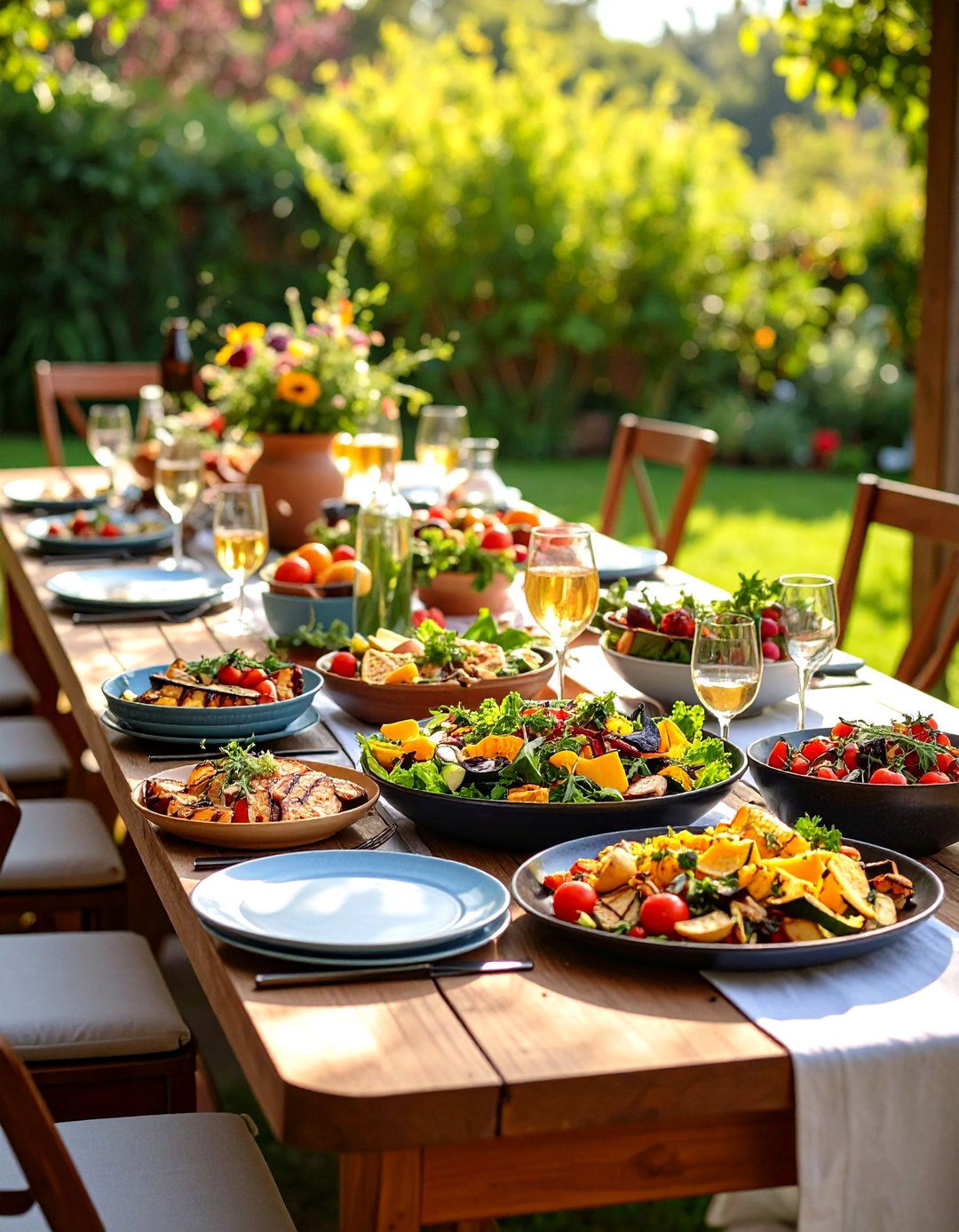
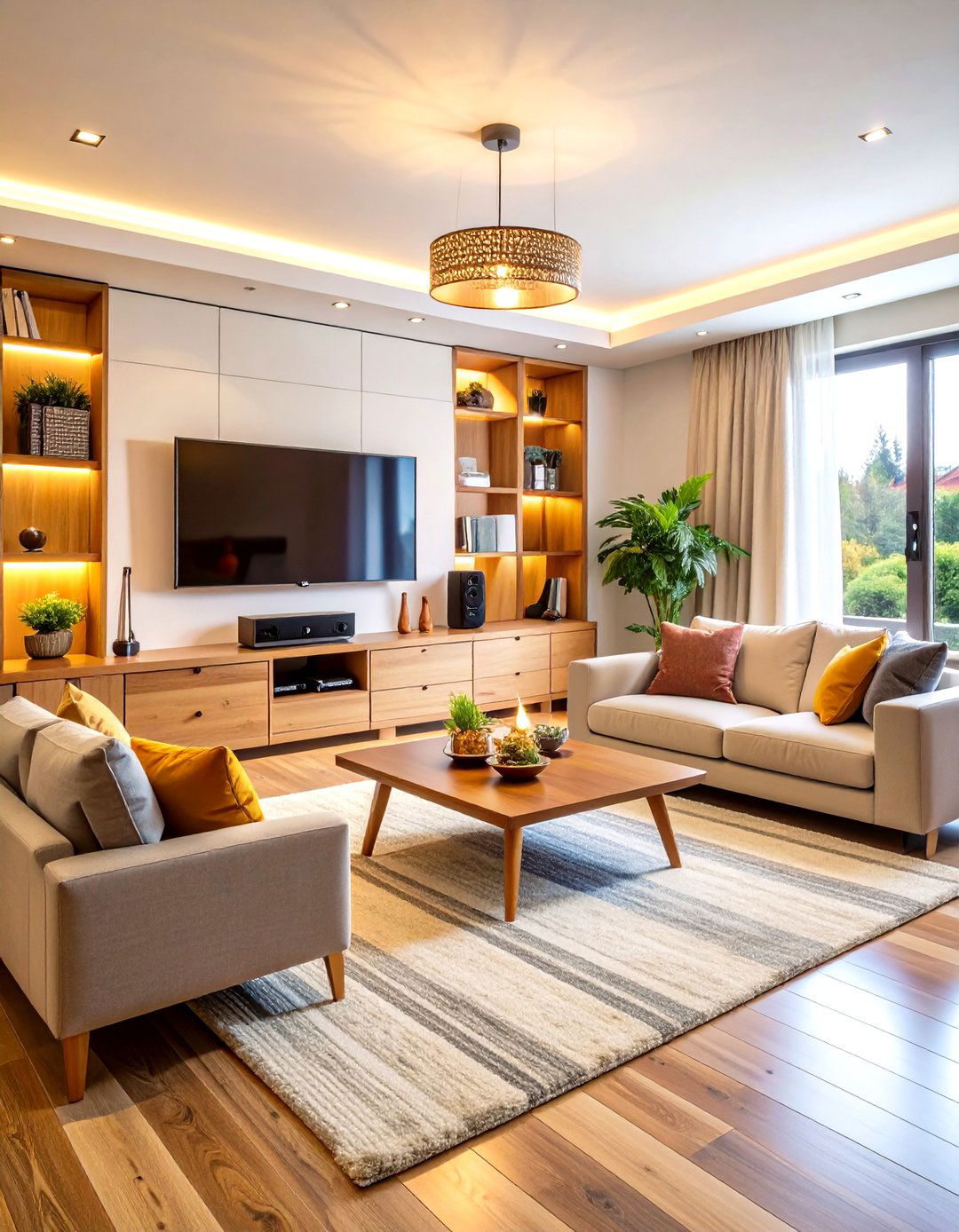
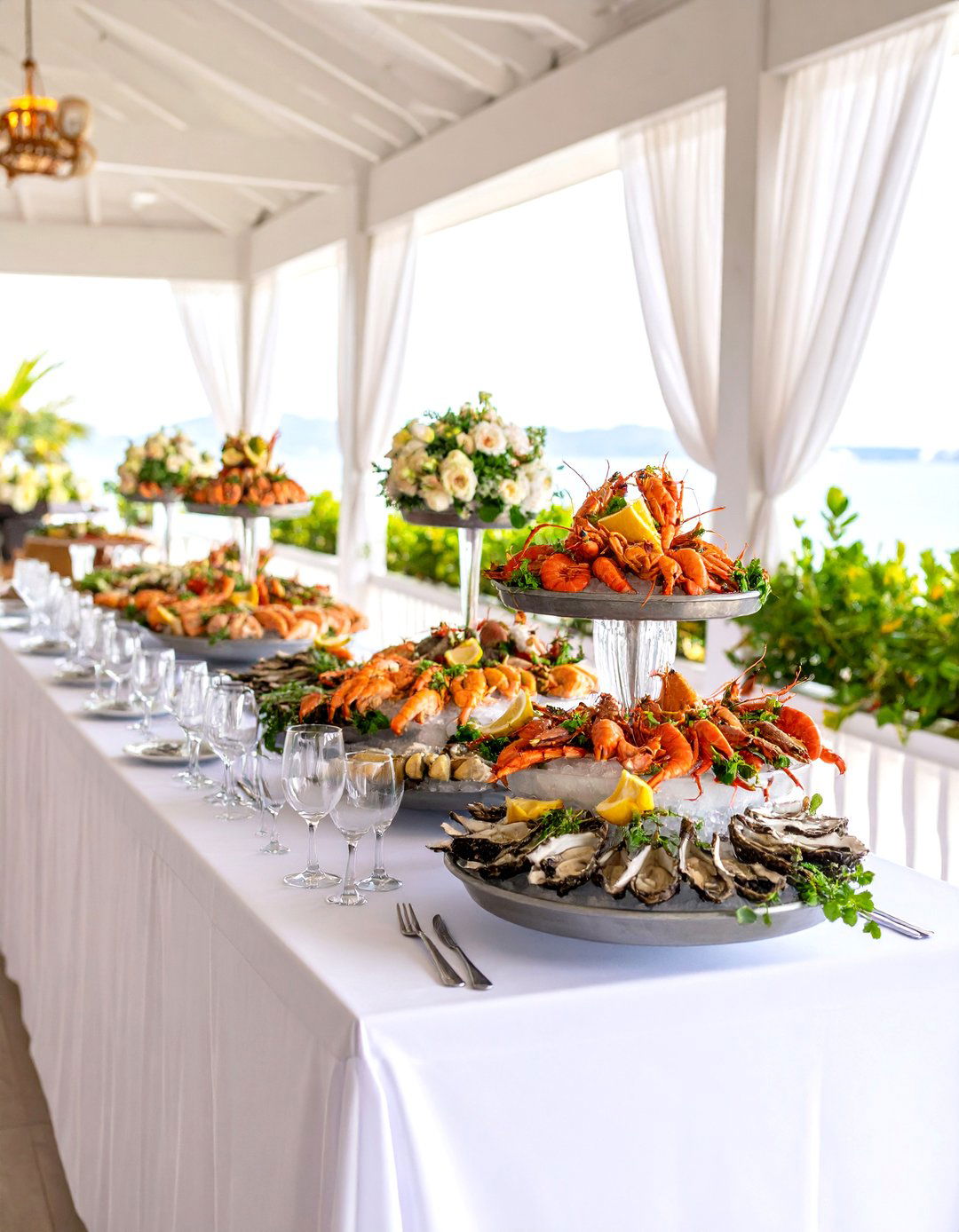
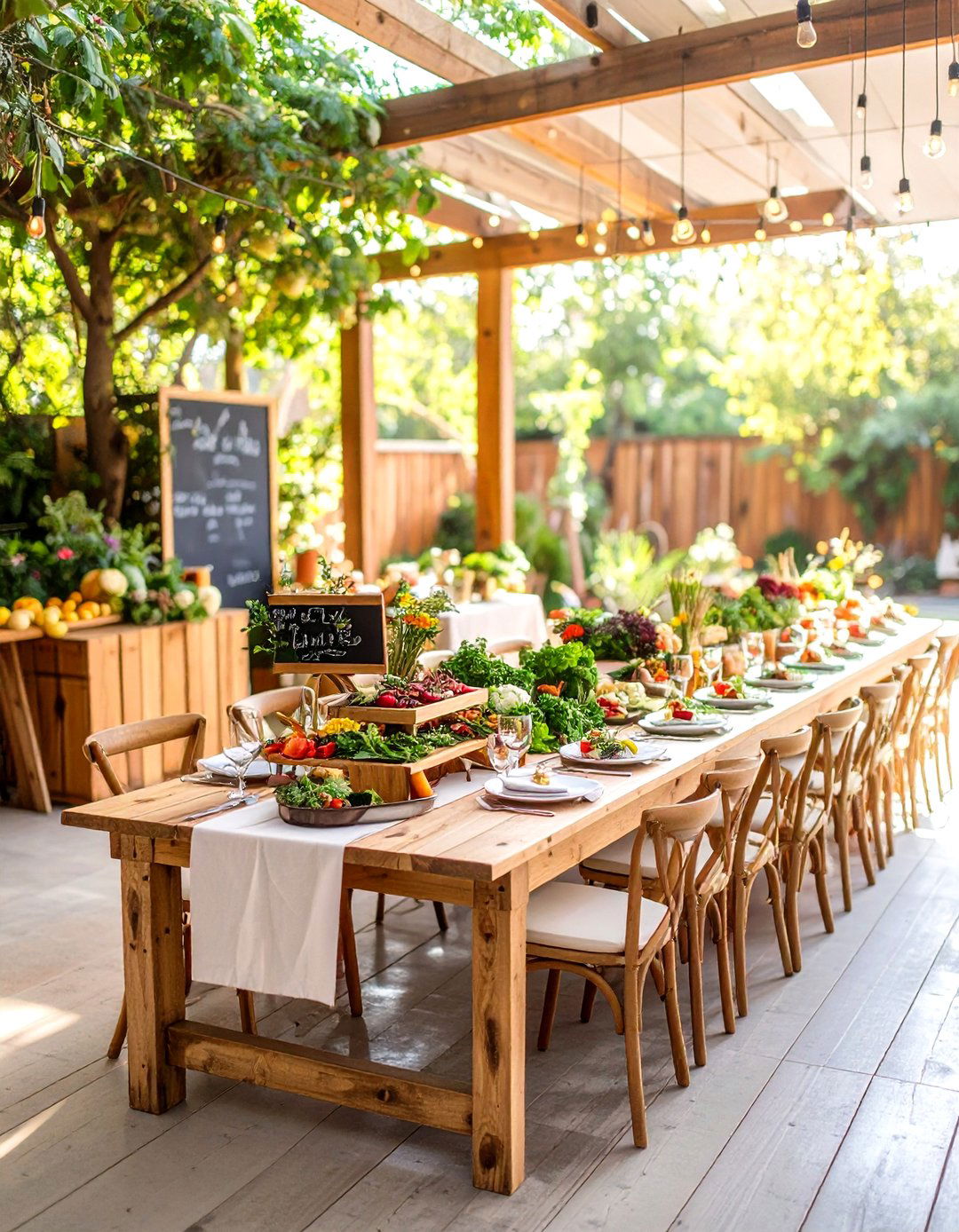
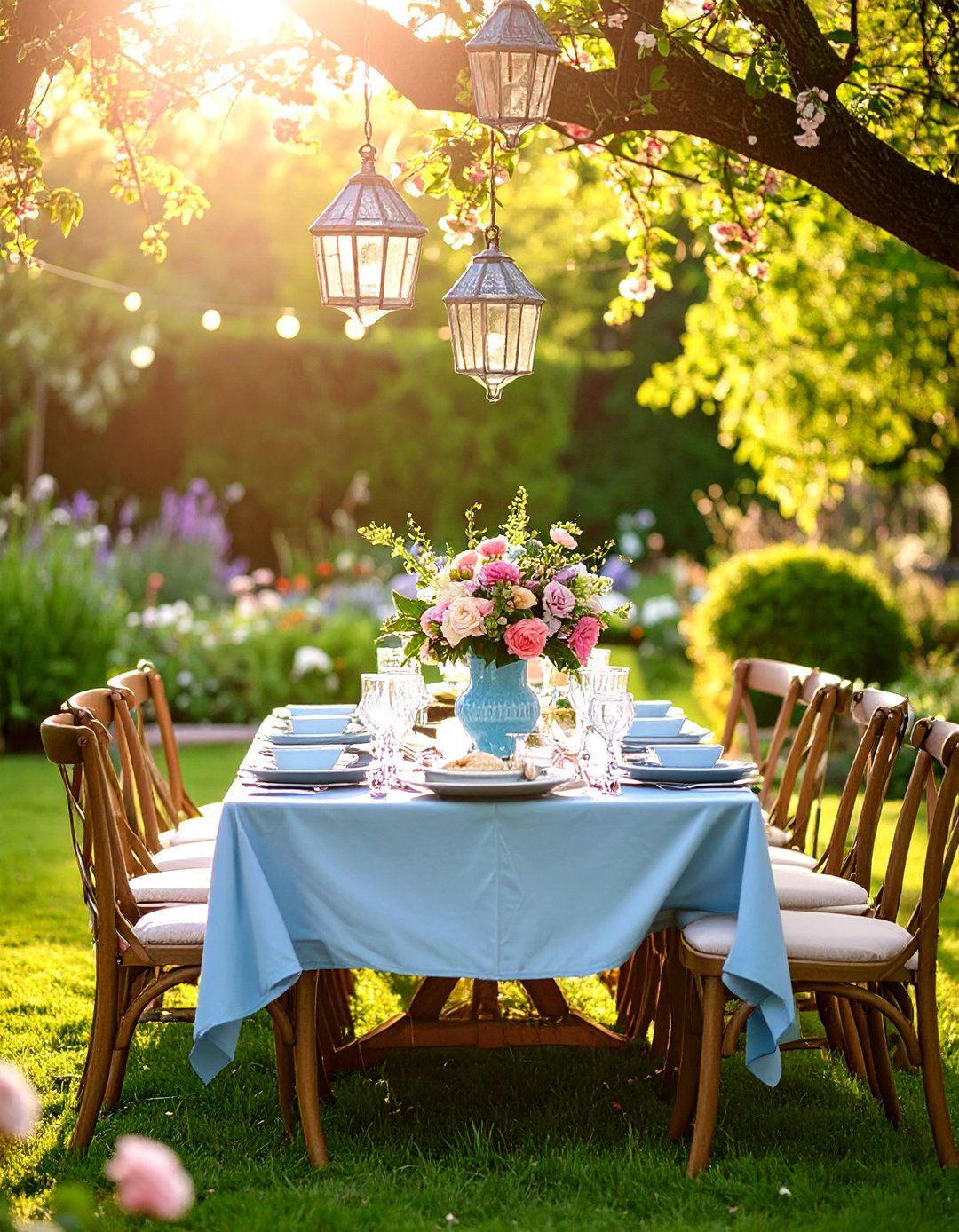

Leave a Reply